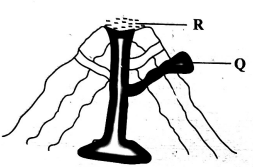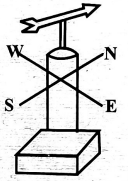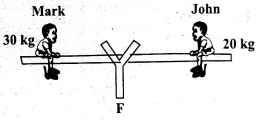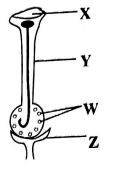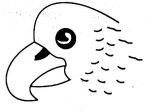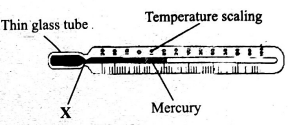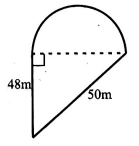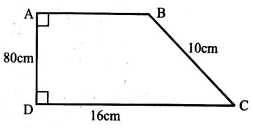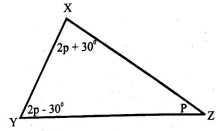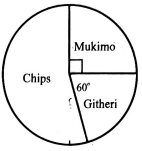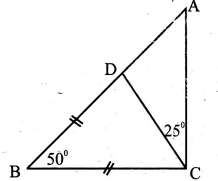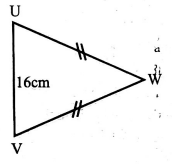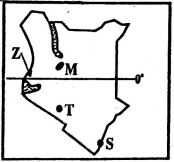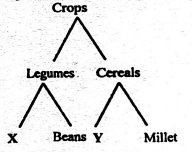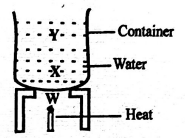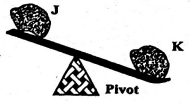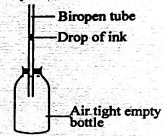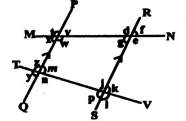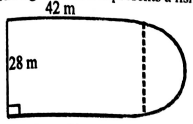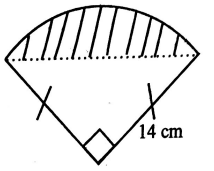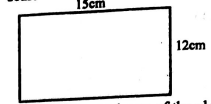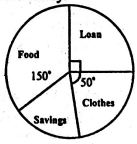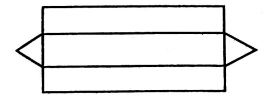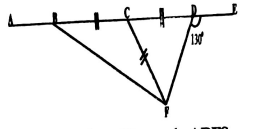Displaying items by tag: End Term 2
Social Studies & Religious Education Questions and Answers - Class 8 End Term Exams Term 2 2023 Set 2
PART 1: SOCIAL STUDIES
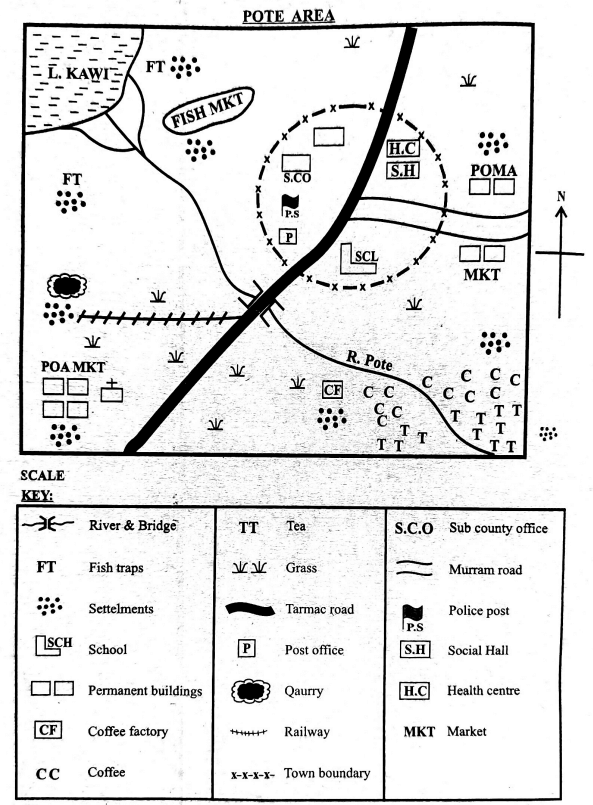
Study the map of POTE AREA and use it to answer questions 1 to 7.
- What is the general flow of River Pote in Pote area?
- South East to North West
- North West to South
- North East to South West
- South East to West
- What is the length of the railway in the map in kilometres?
- 5km
- 5.8km
- 6.2km
- 4.7km
- The population distribution in Pote area is mainly influenced by;
- transport system
- drainage system
- economic system
- security.
- The feature formed at the mouth of R. Pote is known as;
- confluence
- delta
- estuary
- tributary
- Which one of the following economic activities is not carried out in Pote area?
- Fishing
- Mining
- Crop farming
- Lumbering.
- The type of soil found at the mouth of R. Pote is likely to be;
- black valcanic
- alluvial soil
- sandy soil
- volcanic soil
- Pote town has grown to its present size mainly because of;
- government policy
- mining activities
- presence of a road junction
- security
- The following are Nilotes found in Eastern Africa. Which one did not disperse from Pubungu Pakwach?
- Lugbara, Acholi
- Luo, Acholi "
- Lango, Labwor
- Dinka, Shilluk
- Which one of the following was not a function of the clan elders in traditional African Societies?
- It protected the community
- It solved disputes
- It gave members a sense of belonging
- It assisted one another during difficulties
- Below are descriptions of a certain hominid.
- Made tools from stones.
- Ate cooked food.
- Communicated through speech.
The hominid described is likely to be;- Homo Erectus
- Homo Habilis
- Australopithicus
- Zijanthropus Boisei.
- The taking up of responsibilities and position of a person who has passed on is terms as;
- inheritance
- law of succession
- letter of administration
- succession.
- Which one of the following types of marriages allows polygamy and a marriage certificate to be issued?
- Civil marriage.
- Islamic marriage.
- Christian marriage.
- Customary marriage.
Use the diagram below to answer questions 13 and 14.
- The part marked Q is called;
- dyke
- lava
- vent
- conelet
- All the following are examples of the lakes formed at part R except;
- L. Paradise
- L. Shala
- L. Chala
- L Teleki.
- Which one of the following countries was used to resettle the freed slaves?
- Ethiopia
- Sierra Leone
- Nigeria
- Liberia.
- Why do police officers attend political rallies?
- To protect politicians.
- To control rioters.
- To ensure that those in attendance are secure.
- Because it is a requirement of the law.
- The main reason why Kenyans waged armed struggle against the colonialists was to;
- gain political independence
- get back their land
- get Western education
- protect their culture.
- It is the responsibility of the parents in a family to;
- buy anything their children ask for
- provide basic needs to their children
- beat their children
- respect and obey their children.
- Which one of the following statements is true about the weather instrument below?
- The tail points where the wind is blowing
- It is used to measure the strength of wind
- It is used to show the speed of wind
- The arrow points where the wind is blowing from.
- Which one of the following is the main factor that influences the population distribution in Africa?
- Economic factors
- Government policy
- Physical factors
- Social factors.
- The following are statements about a leader in Africa.
- He was champion of Pan Africanism
- He led his country to independence
- He was a founder member of OAU
- He retired voluntarily from active politics.
The leader described above is likely to be;- Leopold Sedar Senghor
- Nelson Mandela
- Jomo Kenyatta
- Haile Selassie.
- Which one of the following is the main reason that led to the fall of Buganda Kingdom?
- Collapse of the long distance trade.
- The coming of the British colonizers.
- Succession disputes.
- Attacks by the almoravids.
- The government of Kenya spends its revenue in all the following ways except;
- paying its workers
- building roads
- supporting emergency services
- paying fines for the law breakers.
- In the past, the Maasai and the Agikuyu mainly interacted through;
- wars
- ceremonies
- trade
- games and sports
Use the map of Africa below to answer questions 25 to 29.
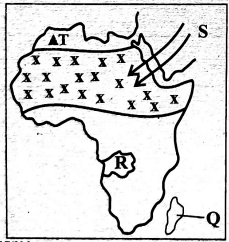
- The capital city of the country marked Q is;
- Moron
- Bamako
- Naukchott
- Antananarivo.
- Name the prevailing winds marked S;
- Harmattan winds
- Westerly winds
- North East trade winds
- South East monsoon
- The best explanation as to why the region marked XXX is sparsely populated is;
- it is covered with thick forest
- It is hot and dry
- It is mountainous
- It experiences floods.
- The country marked R is a former colony of the;
- British
- Spain
- Portuguese
- Germans.
- The mountain marked T was formed as a result of;
- volcanicity
- faulting and uplifting
- folding
- erosion.
- The main difference between the Fulani of Nigeria and the Maasai of Kenya is that;
- the Maasai keep cattle, sheep and goats while the Fulani keep pigs and camels only
- the Fulani use horse back to scout for pastures while the Maasai do not
- the Maasai live in temporary structures while the Fulani live in permanent structure
- the Fulani depend on meat and milk while the Maasai grow crops to supplement their diet.
- Which one of the following pre-historic sites is correctly matched with the country where it is found?
- Olduvai Gorge - Uganda
- River Omo Basin - Tanzania
- Orlogesaillie - Kenya
- Ishango - Ethiopia.
- Which one of the following is negative effect of physical features?
- Provide water for irrigation
- Help in the formation of rainfall
- They are sources of minerals
- They hamper construction of roads
- Which one of the following reasons has contributed to the high life expectancy in Germany?
- High standards of living.
- Small families.
- High population density.
- More old people.
- The following are political organisations formed in Kenya before 1939. Which one was the earliest?
- Young Kikuyu Association
- Kikuyu Association
- Young Kavirondo Association
- East African Association.
- The Harambee spirit is one of the national philosophies. It united Kenyans in eradicating all the following except;
- colonialism
- poverty
- diseases
- illiteracy
- In a school, conflicts can be resolved using the following methods except;
- mediation
- arbitration
- litigation
- negolfation.
- Which one of the following is not a use of cloves?
- Making body oils and lotion
- Making perfumes
- Food preservation
- Spicing food.
- Which one of the following is not a similarity in tourist attractions in kenya and Switzerland?
- Cultural attractions
- Snow-capped mountains
- Beautiful scenery
- Warm climate throughout the year.
- The following are problems facing settlement schemes in Kenya except:
- ethnic hatred and conflict
- improved standards of living
- poor state of roads
- inability to repay loans.
- Three of the following factors lead to slow population growth. which one does not?
- Favourable climate
- High standards of living
- Higher education
- Late marriages.
- Which one of the following is not a role of the school management committee?
- Deciding on new development.
- Hiring and dismissing school workers.
- Representing government in the school.
- Ensuring that the school standards are maintained.
- The following are traditional methods of observing weather. Which one indicated the coming of a dry season?
- A sudden rise in temperature
- The smell of moist soil
- Shedding of leaves by some trees
- Presence of dew in the morning.
- Three of the following are negative factors that influence climate change except;
- afforestation
- industrialisation
- global warming
- use of petrol as a source of energy.
- Which one of the following is not an importance of marriage institution in a community?
- Enhance unity and co-operation.
- Provide companionship.
- Promotes HIV/AIDS transmission.
- Develops responsibilities.
- The diagram below shows a road sign. It is an example of;
- warning sign
- regulatory sign
- informative sign
- no entry.
- Which one of the following UN agencies deals with the plight of refugees?
- UNESCO
- UNICEF
- UNHCR
- UNEP
- Three of the following are effects of the revolution of the earth. Which one is not?
- Causes different in seasons
- Causes difference in length of day and night
- Causes difference in time along different longitude
- Influences the position of the midday sun.
- L. Tana and L. Kivu were formed through a process called;
- downwarping
- volcanicity
- erosion
- human activities.
- Kamenju wants to start a bakery business. Which one of the following factors should he consider most?
- Availability of a market.
- Government policy.
- Security,
- Availability of raw materials.
- The Berlin conference marked the beginning of;
- abolition of slave trade
- partition of Africa
- establishment of traditional government
- construction of the railway line.
- The following are true statements about the Khoisan! Which one is not?
- They had a yellowish-brown complexion.
- Their language has a click sound.
- They were the earliest inhabitants of South Africa.
- They both had a centralized form of government.
- The method of irrigation used in Mwea Tebere irrigation scheme is;
- Basin irrigation
- Furrow irrigation
- Overhead irrigation
- Sprinkle irrigation.
- The method of fishing shown in the diagram below is likely to be used in;
- fish ponds
- deep seas
- lakes
- big rivers,
- The third chapter of the Kenya constitution deals with;
- the republic
- land and environment
- citizenship
- bill of rights.
- Which one of the following is the cheapest method of fish preservation?
- Sun drying
- Smoking
- Salting
- Canning:
- Which one of the following is a cause of conflict in the society?
- Corruption
- Democracy
- Fair distribution of resources
- patriotism.
- Cases concerning children are heard by the;
- Court of appeal
- The Supreme court
- Juvenile court
- Court martial.
- The best place to cross a busy road is;
- zebra crossing
- flyover
- round about
- foot bridge.
- Which one of the following was not a requirement for assimilation in West Africa?
- Readiness to practise French culture
- Ability to read and write in French
- Converting to Islamic
- One had to have only one wife.
- The following are countries of Africa. which one is correctly matched with its capital city?
- Angola - Port Novo
- Ivory Coast - Abidjan
- Egypt - Praia
- South Africa - Pretoria
PART TWO
CHRISTIAN RELIGIOUS EDUCATION
- The main reason why God sent man out of the garden of Eden was;
- the man had known good and evil
- the woman convinced man that the fruit was good
- man disobeyed God
- The serpent was cunning.
- After the floods, the first thing that Noah did was;
- counting the number of animals in the ark
- singing praises to God
- making an altar to the Lord
- opening the floodgates of heaven.
- Abraham is considered to be righteous because;
- he did not have children
- Sarah was old
- he gave birth to Isaac in old age
- he had faith in God.
- Joseph refused to have sex with Potiphars wife. Which commandment did he obey?
- Seventh
- Sixth
- Tenth
- Eighth
- These activities occurred during the passover. Which one is not correctly matched with its meaning?
- Blood on doorposts - protection
- Bitter herbs - slavery
- Eat while standing - hurry
- Unleavened bread - protection
- When Moses ran away from Egypt, he fled to;
- the land of Moab
- the land of Midian
- Jerusalem city
- Canaan.
- Which one of the following commandments did Ahab break?
- Do not covet.
- Do not commit adultery.
- Observe the Sabbath day and keep it Holy
- Honour your father and mother.
- Which one of the following miracles was performed by both Elisha and Elijah? A
- Healed people from leprosy.
- Multiplying oil.
- Raising the widow's son.
- Prophetical coming of the drought.
- Who among the only judges is Israel defeated his enemies with only 300 soldiers?
- Deborah
- Gideon
- Samson
- Samuel
- Who among the following prophets of the Old Testament prophesied about the coming of the Holy Spirit?
- Joel
- Isaiah
- Micah
- Jeremiah.
- Why did King Herod tell the wisemen to pass through his place and tell him about baby Jesus?
- He wanted to worship the baby.
- He wanted to be famous.
- He wanted to see his parents
- He wanted to kill the baby.
- When emperor Augustus ordered a census to be taken, Joseph went to the town of Bethlehem because;
- it was a religious center
- it was nearer Nazareth
- it was his ancestor's birth place
- he was commanded by an angel.
- When was Zachariah the father of John the Baptist doing, when an angel appeared to him? He was,
- preaching in the temple
- asleep
- offering a sacrifice
- burning incense.
- "This is my own dear son with whom I am well pleased." These words were spoken during;
- the birth of Jesus
- the baptism of Jesus
- transfiguration of Jesus
- ascension of Jesus.
- Which one of the following was not a teaching of Jesus about our enemies? We should;
- Be careful when eating with them
- love them.
- pray for them
- forgive them.
- The following accusations were made against Jesus when he was living with the Jews. which one was not? He was accused of;
- blasphemy
- claiming to be king
- working on the sabbath
- fighting against corruption.
- When Jesus was celebrating passover with his disciples during the last supper, he;
- named the greatest among the twelve disciples
- became transfigured
- fed 5000 people
- washed his disciple.
- Who offered his tomb for the burial of Jesus?
- Simon of Cyrene
- Simon Peter
- Joseph of Arimathea
- Andrew.
- Which one of the following happened on the day of Pentesoct?
- 3000 people were converted.
- Holy Spirit came down inform of a dove.
- Jesus ascended to heaven.
- There was darkness for three hours.
- Which one of the following statements found in the Apostle's creed shows that God is the Supreme being?
- Born of the virgin.
- Suffered under Pontius Pilate.
- Descended to the earth.
- Creator of Heaven and earth.
- The following are fruits of the Holy Spirit except;
- healing
- peace
- joy
- goodness.
- Which one of the following beliefs is found both in traditional African Societies and Christian?
- Jesus is the center of worship
- They believe in reading the scripture
- They believe in life after death.
- They believe in God created everything.
- Sacrifices in Traditional African Communities were offered to;
- appreciate God's gift of life
- break the relationship between the living and the ancestors
- be in good relation with God
- enable procreation,
- A baby was welcomed in the clan in Traditional African communities by;
- ululations done by the women
- offering sacrifices and giving offerings
- bringing presents to the baby
- poring libations severally.
- What was the significance of shedding of bllod during circumcission in traditional African societies?
- To unite them with the ancestors
- To make them special members
- To make them strong and healthy
- To prevent them from feeling pain.
- The following are benefits of sharing work except;
- harmony
- better relationship
- discomfort
- happiness.
- The best way for a christian to spend his leisure time is by;
- playing football
- watching movies
- visiting the sick
- visiting friends.
- Different learners celebrated the birth of Jesus in different ways. Who did not celebrate correctly?
- Anitah - Giving offering in church
- Janet - Sharing food in a beer party.
- Mariannah - Join her friends in a beer party.
- Paulette - Attends a worship service.
- Which one of the following statements best shows how christians are helping to reduce the spread of HIV/AIDS?
- Counselling those who are sick
- Providing drugs to the sick
- Keeping away from sinners
- Teaching others on behaviour change and morality.
- Who translated the New Testament Bible to Kiswahili?
- Jacob Ehdarat
- Johanne Rebman
- Ludwig Krapf
- Dr. David Livingstone
PART TWO
ISLAMIC RELIGIOUS EDUCATION
- A lesson that Muslims learn from Surah At-Takathur is that they should
- take care of orphans
- worship only one God
- keep away from worldly things
- observe punctuality in salah
- Which one of the following is a teaching from Surah Nasr?
- Allah is the Creator of the universe
- Victory comes from Allah
- Man was created in the best from
- Muslims should help the poor
- Which one of the following verses from the Quran is found in Surah Al-Kauthar?
- "Verily, you shall see the blazing fire"
- "Woe to every slanderer and backbiter"
- "And the mountains will be like carded wool"
- "Pray to your Lord and sacrifice to him alone"
- The Night of Qadr occurs in the month of
- Dhul Hijjah
- Dhul Qaadah
- Ramadhan
- Muharram
- The main message of Surah Al Ikhlas is
- Seerah
- Tawheed
- Muamalat
- fiqh
- The Surah that asks Muslims to seek refuge from the mischief of created beings is
- Al Fatihah
- Al Lahab
- Al Kafirun
- Al Falaq
- The Prophet (p.b.u.h.) said, "He is not among us who eats and fills up his stomach while his neighbor is hungry." The main teaching of this Hadith is: Muslims must;
- Not eat before their neighbours have eaten
- Treat their neighbours like brothers and sisters
- Not discriminate against their neighbours
- Share their food with their needy neighbours
- Which one of the following is an Islamic rule on eating?
- Eat the food when it is hot
- Start by reciting Bismillah
- Recite Alhamdulillah while eating
- Food should be eaten in a standing position
- Which one of the following Hadith condemns corruption in society?
- "The curse of Allah befalls on both the giver and the recipient of a bribe"
- "Whoever believes in Allah and the Last Day should not annoy his neighbor"
- "Tell the truth even though it is bitter"
- "Whoever is not thankful to people is not thankful to Allah"
- A sunnah act which is performed in preparation for Friday prayer is
- facing Qibla
- covering Aurah
- performing Wudhu
- performing Ghusl
- Which one of the following acts nullifies Saum?
- taking injection
- cooking food
- drinking water
- crying loudly
- Tayammum is an alternative to wudhu. Which parts of the body are common to both?
- forehead and ears
- legs and mouth
- face and legs
- arms and face
- The duty of Angel Israfil is
- blowing the trumpet
- removing the souls
- recording deeds
- bringing rain
- Who among the following Prophets of Allah showed the highest level of patience?
- Yusuf (AS) when thrown into the well
- Issa (AS) when he was rejected by his community
- Ibrahim (AS) on the fate of his sacrifice
- Muhammad (SAW) on the instruction to leave Makkah
- The main reason why Muslims offer greetings before other utterances is because;
- It is a way of making friends
- It is a way of showing concern
- It is a dua
- It is a way of drawing attention
- Which one of the following acts is most likely to lead to corruption?
- begging
- gambling
- taking part in sports.
- Borrowing money.
- When is the dua Alhamdulillah recited?
- Before entering the toilet
- Before meals
- When slaughtering an animal
- After completing a task
- During Lailatul Isra Wal Miraj the Prophet (p.b.u.h.) was commanded to
- fast during kamadhan
- give Zakat
- offer five daily prayers
- perform Hajj
- Which one of the following is the best way of celebrating Idd-ul-Fitr?
- Giving zakatul fitr and going for prayers
- Wearing new clothes and holding a feast
- Going for a family outing
- Visiting friends and relatives
- Which one of the following events took place in the month of Muharram?
- Prophet Muhammad (p.b.u.h) was born
- The Muslims conquered Makka
- Prophet Musa (AS) freed the Banu Israi from Firaun
- Muslims defeated the Quraish in the battle of Badr
- Ali who owns a shop gives the following business practices as his secrets of success. Which one of them is allowed in Islam?
- Hiding goods and selling them at a higher price later
- Allowing people to take goods and pay later
- Selling goods after their expiry date
- Lending money and charging interest on it
- Which one of the following business practices is forbidden in Islam?
- making profit
- charging interest
- selling goods on credit
- giving loans
- Three of the following are reasons why begging is discouraged in Islam. Which one is not?
- It leads to a waste of time
- It encourages laziness
- It leads to loss of self-respect
- It is a means of getting rich
- The first Muslim visitors to the Coast of Kenya came as
- traders
- preachers
- farmers
- doctors
- Which one of the following events took place during Laila-tul-Qadr?
- The Prophet gave his Last Sermon
- The Prophet was born
- The Prophet hid in the Cave of Thaur
- The first revelation of the Quran
- Who advised the Prophet (p.b.u.h.) to dig a trench round Madina during the battle of Khandaq?
- Abu Bakr
- Umar Ibn Khattab
- Salman Alfarsi
- Abu Talib
- The first child to embrace Islam was
- Ali
- Zaid
- Omar
- Uthman
- Majority of the Coastal tribes of Kenya embraced Islam mainly because they;
- Were forced by the Arab traders
- Admired the religious aspect of the Islam
- Were attracted to the open Islamic preaching
- Participated in debate with the Arabs
- Who among the following attended the prayer led by Prophet Muhammad (s.a.w.) at Baitul-Muqqadas during Miiraj?
- Prophets
- Swahaba
- Angels
- Family members
- Which one of the following is the place of worship for the Hindus?
- Synagogue
- Temple
- Church
- Mosque
MARKING SCHEME
SOCIAL STUDIES/ RE
- A
- B
- C
- B
- D
- B
- C
- D
- A
- A
- D
- B
- A
- D
- D
- C
- A
- B
- D
- C
- A
- B
- D
- C
- D
- C
- B
- C
- C
- B
- C
- D
- A
- B
- A
- C
- C
- D
- B
- B
- C
- C
- A
- C
- B
- C
- C
- B
- A
- B
- D
- A
- B
- C
- A
- A
- C
- D
- C
- D
C.R.E
- C
- C
- D
- A
- D
- B
- A
- C
- B
- A
- D
- C
- D
- B
- A
- D
- D
- C
- A
- D
- A
- D
- C
- A
- A
- C
- C
- C
- D
- C
I.R.E
- A
- C
- D
- C
- D
- A
- A
- C
- C
- C
- A
- C
- D
- B
- D
- C
- B
- A
- A
- B
- B
- B
- D
- D
- D
- B
- D
- A
- A
- A
Science Questions and Answers - Class 8 End Term Exams Term 2 2023 Set 2
- Which one of the following effects of drugs is correctly matched with its causes?
Effect Cause A. Drowsiness-
B. Cirrhosis -
C. Addiction -
D. Lung cancer-Injection of cocaine
Smoking of cigarettes
Chewing of miraa
Inhaling of cobblers - The main functions of white blood cells is to;
- fight disease-causing germs
- help in transportation of digested food
- carry oxygen from the lungs to the body
- help in clotting of blood
- The diagram below represents a set-up used by pupils to investigate a certain property of soil.
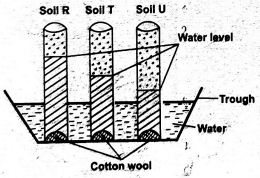
The property of soil investigated is;- drainage
- fertility
- capillarity
- téxture
- The best soil for modelling has;
- high water retention
- low capillarity
- coarse particles
- high drainage
- Which one of the following is a compound fertilizer?
- Calcilum Ammonium Nitrate
- Suphate of Ammonia
- Muriate of potash
- Diammonium phosphate
- Which one of the following is not a way of conserving water?
- Mulching
- using laundry water to clean a house
- Washing vehicles in a water body
- Recycling
- Which one of the following statements is not true about environment?
- It consists of the living things only
- Plants and animals produce carbondioxide.
- Water, air and soil make the non-living component.
- It refers to all things surrounding a living thing.
- Which one of the following is the best way of managing domestic waste in urban centres?
- Reducing its generation.
- Making compost manure.
- Onsite treatment.
- Using local authority services.
- Plants Q, R, S and T had the following characteristics:
Q-Needle-like leaves, thick cuticles
R-Flexible stem, floating leaves
T-Many stomata, waxy leaves.
Which pair of plants are adapted to the same habitat?- Q and R
- Q and S
- O and T
- S and R
- The force that opposes motion can be increased in the following ways except;
- making treads on wheels
- streamlining bodies
- Spreading coarse materials on road
- Making the surface rough.
- Which one of the following uses of heat is not correctly matched with its use?
Source of heat Use A. Gas
B. Sun
C. Fire
D. ElectricityIroning
Drying
Warming
Cooking - The following materials were collected by pupils during a Science practical lesson.
- Water in a basin.
- A clean mirror.
- A white board.
Which aspect of light were they investigating?- Dispersion of light
- Refraction of light
- Reflection of light
- How light travels
- Which one of the following best explains why people should not board matatus that play loud music?
- Makes communication difficult
- Loud sound may damage eardrums
- Loud sound may cause headache
- Loud sound may cause hallucinations
- The diagram below shows two pupils playing on a see-saw.
In order to balance;- Mark should move closer to F
- John should move closer to F
- both should sit at equal distance from F
- Mark should move further away from F.
- Which one of the following groups of materials consists only of good conductors of heat?
- Plastic, glass, copper
- Iron, silver, plastic:
- Glass, copper, gold
- Iron, gold, silver
- Which method of controlling weeds would a farmer apply in a nursery bed?
- Uprooting
- Applying herbicides
- Digging out
- Slashing
- Which one of the following groups consists only of useful small animals?
- Termites, butterfly, locust
- Bees, earthworms, locust
- Termites, bees, earthworms
- Bees, butterflies, earthworms
- The following are characteristics of a certain vertebrates:
- Presence of teeth.
- Presence of gills.
- Presence of tails.
- Presence of fins
- Presence of scales.
Which of the characteristics belong to fish only?- (i) and (ii)
- (ii) and (iv)
- (iii) and (iv)
- (iii) and (v)
- The following are rotational methods of grazing except;
- tethering
- zero grazing
- paddocking
- strip grazing
- Domestic animals are sprayed to control the following except;
- fleas
- tapeworm
- ticks
- lice
- A pupil intended to cut a piece of timber to repair a desk. The most appropriate tool for the work would be:
- hammer
- panga
- knife
- saw.
- A pupil had the following signs and symptoms.
- Skin rash.
- Blood in urine.
- Slight diarrhoea.
The pupil was most likely to be suffering from;- bilharzia
- cholera
- typhoid
- malaria.
- The teeth of carnivores are well spaced to;
- enable them to penetrate into flesh
- enable them to slice and crack bones easily
- prevent flesh from getting stuck between them
- enable them to catch and hold prey.
- A small stone sinks in water while a big log of wood floats. This is because of the difference in;
- shape
- weight
- material
- size.
- Weight is measured in;
- newtons
- kilograms
- volume
- kelvin
- Which one of the following methods of food preservation removes water from the food?
- Use of honey
- Salting
- Freezing
- Use of low temperature.
- Which one of the following can be transmitted from an infected animal to a healthy person?
- Malaria
- Anaemia
- Tuberculosis
- Flea.
- Which one of the following should be avoided when it is raining?
- Touching switches with wet hands.
- Overloading sockets.
- Leaning against walls.
- Putting on shoes with thick rubber soles.
- The following are products obtained from goats except;
- milk
- mutton
- wool
- mohair.
- To stop a moving object, the force applied should be;
- equal and in the opposite direction
- more and in the same direction
- less and in the opposite direction
- more and in the opposite direction.
- In the human digestive system, absorption takes place in all the following parts except one. Which one?
- Stomach
- Mouth
- Ileum
- Colon.
- Three of the following are reasons for H.I.V testing. Which one is not?
- To overcome fear
- To campaign for the spread of H.I.V
- To change behaviour
- To plan for the future one's dependants.
- Pupils of Milimani primary school made a weather instrument using the following materials.
- Thin walled glass bottle
- Biro pen tube.
- Manila paper.
- Coloured water in a basin.
- Stand.
- Rubber band.
Which principle does the instrument they made work?- Air in motion
- Liquid occupy space
- Liquid rise in straw
- Matter expands on heating.
- The diagram below shows a certain part of a flower.
Germination of pollen grains takes place in the part labelled;- X
- Z
- Y
- W
- Which one of the following pairs of processes both leads to the loss of heat to the surrounding?
- Melting and freezing.
- Melting and evaporation.
- Condensation and melting.
- Freezing and condensation.
- The diagram below shows the beak of a certain bird.
The bird is not likely to be a;- vulture
- hawk
- secretary bird
- swan.
- Which one shows all materials that cannot allow magnetism to pass through them?
- Iron, steel, nickel.
- Iron, copper, steel.
- Copper, steel, nickel.
- Alluminium, copper, silver.
- The following are all sources of current electricity except one. Which one?
- Car battery
- Geothermal turbines
- Dynamo
- Solar heater.
- Which one of the following is the functions of dietary fibre found in fruits and vegetables?
- Provides vitamins to the body.
- Helps in the movement of food in the alimentary canal.
- Provides energy to the body.
- Helps in the absorption.
- Infants needs to be breastfed for at least six months mainly because breast milk;
- makes them naturally more resistant to infections
- boosts their energy
- is readily available
- strengthens their bond with the mother.
- The following are causes of water pollution. Which one is not?
- Soil particles.
- Controlled use of fertilizers.
- Untreated sewage.
- Human wastes.
- The main reason why some plants that grow in dry areas have thorns is to;
- reduce water loss
- protect them from brousers
- store extra water
- to make food.
- The following are all pastures except;
- nappier grass
- desmodium
- kikuyu grass
- rhodes grass
- The toothless gap found on the front upper jaw is used for;
- turning of food for proper chewing
- crushing and grinding food
- rolling food in the mouth
- pressing and cutting grass while feeding.
- The diagram below shows a type of interdependence.
The type of interdependence shown is;- shelter
- food
- support
- habitat
- Which one of the following is not a function of the part labelled T on the diagram below?
- Entry of air
- Emergence of plumule
- Emergence of radicle
- Entry of water.
- The percentage of air that excludes oxygen during welding of metals occupy;
- 0.03%
- 0.97%
- 21%
- 78%
- The best method of controlling human. intestinal worms is;
- deworming
- wearing protective gear
- proper cooking of food
- proper sanitation.
- The diagram below shows a certain instrument.
Which is the function of the part labelled X?- Allows contraction and expansion
- Prevents bursting of the glass.
- Expanding the mercury.
- Allows the doctor to read th temperature.
- All thermometers have a scale on them called the;
- degree scale
- celsius scale
- thermometer scale
- temperature scale.
MARKING SCHEME
- C
- A
- C
- A
- D
- C
- A
- D
- B
- B
- A
- A
- B
- A
- D
- A
- D
- B
- B
- B
- D
- A
- C
- C
- A
- B
- C
- C
- C
- A
- B
- B
- D
- A
- D
- D
- A
- D
- B
- A
- B
- A
- A
- D
- D
- B
- B
- D
- D
- D
Kiswahili Questions and Answers - Class 8 End Term Exams Term 2 2023 Set 2
Soma vifungu vifuatavyo. Vina nafasi 1 hadi 15. Kwa kila nafasi umepewa majibu manne. Chagua lifaalo zaidi.
Mawasiliano ni sekta mojawapo __1__hatua sana __2__ kuvumbuliwa kwa teknolojia mpya. Siku hizi hata __3__ wanaohifadhi faili na kupokea simu ofisini wamepunguzwa. Ulimwengu umekuwa duara __4__ tu __5__ habari huweza kuenea __6__ katika muda mfupi sana. __7__, hakuna kizuri kisicho na dosari. Watu wenye __8__ mbaya wanatumia fursa hiyo kusambaza uvumi. Wengine husambaza picha zisizofaa __9__. Tusipochukua tahadhari tutaishia kujiuma kidole kwani
__10__.
| A | B | C | D | |
| 1. | zilizopiga | yaliyopiga | tulizopiga | iliyopiga |
| 2. | hadi | tangu | kuliko | kama |
| 3. | matarishi | masogora | wahazili | mabawabu |
| 4. | ndogo | dogo0 | kidogo | mdogo |
| 5. | ingawa | mathalani | lau | madhali |
| 6. | zote | kote | yote | lote |
| 7. | Labda | Vilevile | Hata hivyo | Isitoshe |
| 8. | nia | lengo | madhumuni | kusudi |
| 9. | redioni | magazetini | dunaini | mitandaoni |
| 10. | baada ya dhiki ni faraja | majuto ni mjukuu | mstahimilivu hula mbivu | dalili ya mvua ni mawingu |
Tangu siku zake za ujanani, Kiburi hakujua maana ya jirani __11__ siku moja __12__ na ya kumfika. Alikuwa __13__ watu ambao waliamini kuwa wakipatwa na __14__ ndugu atawasaidia. Alisahau kuwa __15__.
| A | B | C | D | |
| 11. | mpaka | baada ya | kisha | hadi |
| 12. | alipofikia | alipofikwa | alifikiwa | alifikwa |
| 13. | miongoni ya | katikati ya | kati ya | baina ya |
| 14. | siha | adhabu | maarubu | adha |
| 15. | fimbo ya mbali haiui nyoka | mtegemea cha nduguye hufa maskini | heri nusu shari kuliko shari kamili | akufaaye kwa dhiki ndiye rafiki |
Kutoka swali la 16 hadi 30 jibu kulingana na maagizo.
- Neno mwanahewa lina silabi ngapi?
- Tisa
- Tano
- Nne
- Nane
- Genge ni kundi la watu linalofanya kazi pamoja ilhali kenge ni;
- ndege mwenye sura kama ya paka
- mnyama wa porini afananaye na mbuzi
- samaki afananaye na nyoka
- mnyama kama mamba mdogo
- Ikiwa jana ilikuwa Alhamisi, mtondo ilikuwa;
- Jumatatu
- Jumapili
- Jumatano
- Jumanne
- Andika sentensi ifuatayo katika usemi wa taarifa.
Mama: Mwanangu, utanyolewa kesho jioni.- Mama alimwambia mwanangu angenyolewa kesho jioni
- Mama akamwambia mwanawe atanyolewa siku iliyofuata jioni.
- Mama alimwambia mwanawe kuwa angenyolewa siku iliyofuata jioni.
- Mama alimwuliza mwanawe kama atanyolewa kesho.
- Joka la indimu ni kwa inda ilhali mkono wazi ni kwa;
- ukarimu
- uchoyo
- ujanja
- uvivu
- Ni maelezo yapi sahihi?
- Tathlitha ni shairi lenye mishororo minne kila ubeti.
- Ngonjera ni shairi la historia.
- Malenga hutunga mashairi na nyimbo.
- Tarbia ni shairi lenye mishororo miwili kila ubeti.
- Ki imetumiwaje katika sentensi? Mwalimu alipoingia tulikuwa kukiimba.
- Kuonyesha udogo.
- Kuonyesha kuendelea kwa kitendo.
- Kuonyesha masharti.
- Kuonyesha namna.
- Miongoni mwa sehemu hizi za mwili, ni ipi iliyo tofauti na nyingine?
- Pafu
- Paja
- Kiganja
- Goti.
- Ni methali ipi yenye maana sawa na 'usiache mbachao kwa msala upitao'?
- Usione kwenda mbele kurudi nyuma kazi.
- Usipoziba ufa utajenga ukuta.
- Ganda la muwa la jana chungu kaona kivuno.
- Bura yangu sibadili na rehani.
- Tambua maneno yaliyopigwa kistari. Mwalimu mgeni atajiunga nasi mwakani.
- Kielezi, kihusishi
- Kivumishi, kiunganishi
- Kivumishi, kielezi
- Kiwakilishi, kivumishi.
- Ni jina lipi la makundi lisilofaa?
- Bunda la nyuki.
- Shehena ya mzigo.
- Chane ya ndizi.
- Kilinge cha wachawi.
- Chagua wingi wa sentensi ifuatayo.
Karani na wifi walifika jana.- Makarani na wifi walifika jana.
- Karani na mawifi walifika jana.
- Makarani na mawifi walifika jana.
- Akina Karani na wifi walifika jana.
- Ni sentensi gani iliyotumia kwa kuonyesha sababu?
- Amekula wali kwa mchuzi.
- Alifurahi kwa kufikia utu uzima.
- Tatu kwa tano ya wanafunzi ni wavulana.
- Maria ataenda kwa shangazi yake kesho.
- Ni nomino zipi zilizo katika ngeli ya I-I?
- Maji, marashi
- Meza, dawati
- Mkate, maembe
- Mvua, chumvi
- Ni nahau ipi yenye maana ya kupata taabu au shida?
- Kula mwata
- Kata kamba
- Piga mbiu
- Laza damu.
Soma kifungui kifuatayo kisha ujibu maswali 31 hadi 40.
Subira alikuwa barobaro ambaye hakujimudu kimasomo. Alikuwa kisubutu masomoni. Hata hivyo, alijaliwa kipawa katika riadha. Alionekana kila asubuhi akifanya mazoezi ya kukimbia. Wapo waliomhurumia kuwa huenda hakuwa na akili razini. Weng walisikika wakisema alikuwa akiadhibiwa na Mungu. Akiwa mkembe walidai kuwa alitumwa na nyanya yake gulioni lakini akakataa.
Watu wengi walijisaili mbona akaanza kukimbia miaka mitano baada ya nyanya yake kutembelewa na Izraili wa kaputi. Baada ya kufanya mazoezi kwa muda mrefu, Subira alianza kushiriki katika mashindano mbalimbali. Aliposhiriki mara ya kwanza, alishika nanga licha ya mazoezi ya bidii nyingi.
Aliendelea kufanya mazoezi pasi na kwenda nguu. Alivyozidi kujitahidi katika mazoezi ndivyo wengi walivyoendelea kumbeza. Hakubwaga silaha kamwe. Aliamini lisani ya wahenga isemayo kuwa atafutaye hachoki na akichoka keshapata. Mwaka uliofuata akiwa na umri wa miaka kumi na sita alishiriki tena katika mbio za masafa marefu. Alipata mwamko mpya alipofahamu kuwa ingawa hakushinda hali yake ilizidi kuimarika.
Alizidi kujiongeza maarifa. Akawa na matumaini kama tai kuwa siku moja angeibuka kifua mbele. Nusu mwaka baadaye, Subira alichaguliwa kuwa miongoni mwa wawakilishi wa nchi yao katika mbio za masafa marefu duniani. Huo ukawa ndio mwanzo mkoko unaalika maua. Nyota yake ikaanza kung'aa na mambo yakaanza kumwendea mserego. Aliamini lisani ya wahenga isemayo kuwa papo kwa papo kamba hukata jiwe.
Ulimwengu mzima ulishuhudia Subira akinyakua nishani ya dhahabu katika michezo hiyo duniani. Subira aliyekuwa akidhalilishwa na kupakwa tope akawa anasifika kote. Jina lake likawa kibwagizo midomono mwa wengi. Miaka michache baadaye akawa tajiri wa kutajika. Waliomcheka wakakosa pa kuziweka nyuso zao. Walipata funzo kuwa dhamira ni dira na nia zikiwa pamoja, kilicho mbali huja karibu.
- Kulingana na aya ya kwanza, ni kweli kusema kuwa;
- Subira alikuwa wembe shuleni
- Subira alifanya mazoezi ya kukimbia machweo
- Subira alihurumiwa na wanakijiji wote
- Subira hakujiweza sana masomoni
- Baadhi ya wakazi walisema kuwa Subira alikuwa akiadhibiwa kwa sababu;
- hakuwa na akili timamu
- akiwa mdogo alitumwa na bibi yake lakini akakataa
- hakuwa mcha Mungu
- mienendo yake haikuvutia
- Neno gulioni lina maana gani kulingana na kifungu?
- Sokoni
- Dukani
- Mtoni
- Shambani
- Ni methali ipi mwafaka kuelezea tabia za Subira baada ya kushindwa katika jaribio la kwanza?
- Mbio za sakafuni huishia ukingoni
- Asiyekujua hakuthamini.
- Kuvunjika kwa mwiko si mwisho wa upishi.
- Mtegemea nundu haachi kunona.
- Ni nini maana ya alishika nanga kulingana na kifungu?
- Alipoteza matumaini
- Alikuwa wa mwisho.
- Alibadili nia.
- Alikuwa wa kwanza.
- Kushinda kwa Subira hatimaye kulitokana na;
- ujuzi, bidii na tamaa
- umri, ujana na utepetevu
- laana, maarifa na bidii
- bidii, ulegevu na ujuzi.
- "Akawa na matumaini kama tai." Hii ni mfano wa fani ipi ya lugha?
- Kinaya
- Chuku
- Istiara
- Tashbihi.
- Subira alikuwa akishiriki michezo katika dunia nzima. Hii inamaanisha alikuwa;
- hadhi yake ya kimichezo ilipanda
- mtalii wa kutembelea mataifa
- mweledi wa kusafiri miji mikubwa
- mpenda anasa za dunia.
- Ni nini maana ya kupakwa tope kulingana na kifungu?
- Kutegemewa
- Kuharibiwa jina
- kuaibishwa
- kuchukizwa.
- Kichwa kinachofaa kifungu hiki ni kipi?
- Juhudi si pato.
- Tusiwe wa kutegemea wengine.
- Uvumilivu hutamausha maishani.
- Tusikate tamaa.
Soma kifungu kifuatacho kisha ujibu maswali 41 hadi 50.
Kila mwanadamu ameumbwa akiwa na uwezo wake maalum. Mungu alifanya hivyo makusudi kabisa. Hebu fikira ulimwengu wenye watu ambao kila mmoja anajitosheleza. Yaani kila mtu anaweza kujifanyia kila kitu apendavyo. Ulimwengu usingehitaji watu wanaosomea kazi mbalimbali wala watu wasingetegemeana. Upendo na huruma vingekuwa havipo dunaini.
Mungu aliwaumba watu na vipawa vyao mbalimbali. Hata wanaofikiriwa kuwa hawana vipawa, ukiwachunguza vizuri utaona kuwa wana upekee fulani katika jambo wanalolimudu vizuri. Wakati mwingine, sio lazima jambo hilo liwe kubwa sana kiasi cha watu kulizungumzia. Kuna watu wasiokuwa na uwezo mkubwa wa kiuchumi lakini waliobarikiwa kwa uwezo wa kuzungumza vizuri au uwezo wa kuwashauri wengine wenye mahitaji mbalimbali. Hili linatukumbusha kuwa hata vipawa tunavyofikiri kuwa si vikubwa vina thamani kubwa ajabu.
Ingawa kila mtu ana kipawa chake, kuna watu wengi wasioweza kutambua vipawa vyao. Sababu moja inayowafanya washindwe kutambua vipawa hivyo ni kule kutokuwa na mtu wa kuwaongoza na kuwahimiza kuandama safari ya vipawa vyao. Sababu nyingine ni kwamba watu wengine hawaviamini wala kuvithamini vipawa vyao. Kwa mfano mtu anaweza kuwa na kipawa cha kucheza kandanda lakini akawa anataka kuwa daktari hata kama huo udaktari haumo katika damu yake. Mtu anapopuuza kipawa chake na kukifuata kingine tofauti huwa hana hamy na raha ya kufanya kazi ambayo hatimaye atakuwa amechagua kuifanya.
Wakati mwingine watu hupotishwa kuviacha vipawa vyao. Jamaa na marafiki huweza kumshawishi mtu kukiacha kipawa chake na badala yake kukifuata kile cha wale wanaomshauri. Mara nyingi wanaomshawishi mtu kuacha kipawa chake huwa hata hawajauelewa uwezo wa wanayemshauri. Japo watu wengine hufanikiwa kwa kuelezwa kufuata njia ambayo haikuwahusu, wengine hushindwa kufanikiwa, huwa kuna asilimia kubwa inayojilazimisha kuifanya kazi amambo haihusiani na talanta yao moja kwa moja.
Ni vizuri kutambua kwamba kuwa na kipawa tu hakutoshi. Kipawa cha mtoto ni mche unaohitaji maji, mwanga na mazingira mazuri yasiyo na magugu ili uweze kuimarika na kustawi, la sivyo utanyauka na kukauka. Mwenye kipawa anafaa kukilea kwa kukifanyia mazoezi ili kukiboresha. Anafaa kuwa na nidhamu ya kukiendeleza hadi kitakapokomaa. Anahitaji kufuata ushauri na mwongozo wa watu wengine ambao wamekitumia vizuri kipawa sawa na chake.
Tunafaa kutambua kuwa vipawa ni vingi jinsi walivyo watu. Vilevile hata watu wenye kipawa kile kimoja wana uwezo tofauti. Kama wasemavyo wahenga akili ni nywele kila mtu ana zake. Tukumbuke kuwa hata vidole havilingani
- Kulingana na aya ya kwanza ni kweli kuwa;
- bila kuwa na elimu wanadamu hawawezi kusaidiana
- kila binadamu ana mambo maalum anayopenda
- watu wanaojifanyia kila kitu huwashangaza wanajamii
- hali ya kutegemeana husaidia kujenga maadili.
- Kwa mujibu wa aya ya pili;
- watu wengi hudhani kuwa wengine hawana vipawa
- kuna vipawa vya thamani kuliko vingine
- wakati mwingine watu wenye vipawa hawagunduliwi
- wasiokuwa na uwezo mkubwa wa kiuchumi wamebarikiwa.
- Kifungu kinaonyesha kuwa watu wengi hawawezi kutambua vipawa vyao kwa sababu;
- hukosa mwongozo unaofaa wa kukuza vipawa vyao
- huwa hawafurahishwi na vipawa vyao kama wenzao
- huwaza kuwa kutambua vipawa kunachukua muda mrefu
- hufikiri kuwa kipawa cha udaktari ndicho bora maishani.
- Ni kauli ipi sahihi kulingana na kifungu?
- Wasiojua umuhimu wa kazi huwazuia wengine kushughulikia kazi zao
- jamaa na marafiki huweza kumnyima mtu fursa ya kukuza kipawa chake
- wanaotoa ushauri kuhusu vipawa huwa wanawajua wenye vipawa hivyo
- kubadilisha kazi huifanya isiwe ya kuvutia kwa wale wanaifanya
- Kifungu kimebainisha kuwa;
- watu hufanya vizuri kuwashauri wengine kuacha vipawa vyao
- ushawishi wa marafiki huwa mkubwa zaidi kuliko wa wenye kipawa
- baadhi ya wanaoshauriwa kufuata vipawa tofauti na vyao hufaulu maishani
- ukujazi wa vipawa hutofautiana kulingana na imani ya mtu kwa Mungu
- Ni maelezo yapi si sahihi kulingana na mwenye kipawa?
- Anahitaji kukifanyia mazoezi ili kukiboresha
- Anahitaji kuhakikisha amekiimarisha hadi kitakapokomaa.
- Anafaa kufuata mfano wa wengine wenye vipawa sawa na chake.
- Anafaa kuwategemea wengine kukijenga kipawa chake
- Ni neno lipi ni kisawe cha kipawa?
- Nishani
- Ilhamu
- Kipaji
- Dhima
- Maneno... kipawa cha mtoto ni mche unaohitaji maji." yametumia fani ipi ya lugha?
- Istiara
- Tashbihi
- Kinaya
- Majazi
- Katika kifungu maana ya methali "Akili ni nywele kila mtu ana zake' ni;
- watu wenye hamu ya kushirikiana hutofautiana
- viwango vya uwezo wa watu vinatofautiana
- mitazamo ya watu kuhusu vipawa ni tofauti
- watu wanaothamini vipawa hutofautiana.
- Ni nini maana ya wanalolimudu kama ilivyotumiwa katika kifungu?
- Wanaloweza kulifanya
- Wanalolipenda
- Wanaloliamini
- Wanalofurahia kulipenda.
INSHA
Umepewa dakika 40 kuandika Insha yako.
Malizia insha yako kwa maneno haya.
................................................................................................................Hakika tukio la siku hiyo haliwezi kusahaulika maishani.
MARKING SCHEME
- D
- B
- C
- A
- D
- B
- C
- A
- D
- B
- D
- B
- C
- D
- A
- C
- D
- A
- C
- A
- C
- B
- A
- D
- C
- A
- C
- B
- D
- A
- D
- B
- A
- C
- B
- A
- D
- A
- C
- D
- D
- C
- A
- B
- C
- D
- C
- A
- B
- A
English Questions and Answers - Class 8 End Term Exams Term 2 2023 Set 2
Read the letter below. It contains blank spaces numbered 1 to 15. For each blank space choose the best alternative from the choices given.
Dear Editor,
My name is Abigael Mwikali. I __1__ something that I would like to share with my fellow youth and Kenyans in __2__.__3__
is the use of sheng. Experts say that sheng is a mixture and corruption of Kiswahili, English and a sprinkling __4__
local languages.
Let me be very candid. Sheng should be __5__ because it dilutes, pollutes and erodes the standards of English, Kiswahili __6__ local languages. It __7__ people to switch from one language to another and mix them at will. It does not __8__ to any rules and standards. This affects the mastery of any one language. The widespread of sheng is to blame for the __9__ performance in English and Kiswahili in the K.C.P.E examination.
__10__ people and professionals do not use sheng. In deed no self-respecting individual would be held using the weird language, if it qualifies to be called a language. It is the __11__ of conmen who rely on it to __12__ disrespectful and inane messages. It is __13__ the language of result for deviant and rebellious teenagers in school and at home. In __14__ it, they show disrespect to authority and order. Policy makers should outlaw sheng __15__ they are serious about developing foreign, national and local languages.
Yours truly,
Abigael Mwikali.
Standard 8 pupil.
| A | B | C | D | |
| 1. | posses | had | have | has |
| 2. | particular | fact | general | dead |
| 3. | Its | This | These | Here |
| 4. | in | on | for | of |
| 5. | destroyed | dismissed | banned | unused |
| 6. | then | and | before | together |
| 7. | allows | let's | shows | stops |
| 8. | confirm | follow | confine | conform |
| 9. | poor | good | excellent | slow |
| 10. | Youthful | Respectively | Respectable | All |
| 11. | properly | preserve | thing | idea |
| 12. | pass | tell | use | say |
| 13. | also | however | so | now |
| 14. | having | using | talking | showing |
| 15. | if | since | because | un/ess |
For question 16 to 18, choose the best answer to complete each sentence.
- They __________________ on the beach, enjoying a cool breeze.
- laid
- lain
- lay
- lied
- We watched the soldiers _______________________ majestically into the stadium.
- much
- match
- munch
- march
- If you are not careful, you will ______________________ all your friends.
- lose
- loss
- loose
- lost
For questions 19 and 20, choose the word that means the anatomy of the underlined word.
- The whole town celebrated the freedom of the hostages.
- humility
- captivity
- ability
- festivity
- We felt inferior when the other pupils started laughing at us.
- exterior
- junior
- interior
- superior
For questions 21 and 22, choose the correct meaning of the given idiom.
- To be at logger heads.
- To have a headache
- To be quarreling
- To be confused
- To get along well.
- To give someone a cold shoulder.
- To treat someone harshly
- To be unfair to someone
- To make someone feel unwelcome
- To be hostile to someone.
For questions 23 and 24, choose the correct order of adjectives to fill in the blank spaces.
- Diana bought a ___________________ dress.
- long, costly, beautiful
- beautiful, long, costly
- costly, beautiful, long
- beautiful, costly, long
- Aunt Rose married a ________________ man.
- tall, dark, handsome
- handsome, dark, tall
- handsome, tall, dark
- dark, handsome, tall
For questions 25, choose the correct phrasal verb to complete the sentence.
- Marube finally __________________________ his alcohol addiction.
- got down
- got off
- got out
- got over
Read the passage below and then answer questions 26 to 38.
It was on Thursday morning during the school holidays when Otieno was alone at home. His younger brother, Sam and three sisters had gone to play with the children of the neighbours. To while the day away, he had been sitting down under a tree reading an interesting storybook. His mind had been fully absorbed in the story that he was reading. Suddenly he remembered that he has Science homework to do. An experiment of all things! But the temptation to read the storybook was irresistible. Could the homework wait until later? Nevertheless Otieno reluctantly put down the book and decide to carry out the experiment.
As he was rushing to the kitchen, he slipped in a puddle of water which he had forgotten to wipe and found himself skidding on the floor. He was left unscathed as he hurt his ankle.
On most occasion, Otieno liked using his home-made burner to carry out Science experiments in his bedroom. He impatiently tried to look for his burner but he could not find it. After failing to trace the burner, he got hold of his salt solution and switched on the cooker. He became impatient as the cooker seemed to heat rather slowly, as if on purpose just to annoy him. But as he put the container on the cooker what he did not realise was that he had switched it on fully. Then Otieno went back to his book and left the solution boiling, hoping to be back in a few minutes. The part he was reading become so exciting that he soon forgot about the experiment. tied up with ropes and The story was about a detective who had got himself locked up in a room, a time bomb in a corner ready to blow up any minute! He was counting the minutes and.....
Suddenly, Otieno heard a loud bang go off somewhere in the kitchen within a fraction of a second. He thought that the bomb had actually exploded, killing the poor detective. Then he remembered his experiment!
Otieno immediately threw his book aside and run to the kitchen where he found smoke billowing from the cooker. he was shaken and frightened even as he tried to turn off the cooker and inspect th damage. Fortunately there was nothing amiss with the cooker.
He hurriedly removed all traces of the burnt solution and cleaned up the messed up place before his parents arrived home from work.
From that day he resolved to always do one thing at a time and at least read storybooks after finishing all other household chores.
- What time is referred to in the first sentence?
- Before midday
- After sunset
- Between midnight and midday
- Between midday and sunset
- To while the day away' mean to;
- waste the day
- spend the day pleasantly
- do something naughty
- get involved in negative activities
- When Otieno thought of the Science experiment, he;
- stopped reading at once
- began to while the day away
- was briefly undecided
- continued reading briefly
- Why did Otieno decide to read a storybook?
- The book belonged to him
- He was sitting under a tree
- There was nothing else to do
- He was at home
- "An experiment of all things! This expression suggested that Otieno;
- detested Science experiments
- had many things on his mind
- liked doing experiments, especially Science one
- was a very busy boy
- The word 'reluctantly' as used in the passage, its opposite is;
- hurriedly
- carefully
- slowly
- eagerly
- What made Otieno hurt his ankle?
- It is normal for boys to hurt themselves
- He was naturally a very careless boy
- In his hurry, he skipped on the floor
- He could tread himself easily
- The word 'unscathed' can be replaced with;
- unhappy
- uninjured
- badly injured
- slightly injured
- Which of the following is not true about the home-made burner?
- Otieno often used it in his bedroom
- It was used by Otieno for Science experiment
- Otieno used it mainly for Science experiment
- Otieno could not trace it when he needed it
- It is true to say that Otieno used the cooker because;
- he wanted quick results
- it was better than his burner
- his burner was unavailable
- cooker are safer to use than burners
- Why did Otieno soon forget about his experiment?
- His mind was on the loud bang in the kitchen
- All his attention was on the story
- The death of the poor detective saddened him
- The cooker was heating slowly to annoy him
- How did Otieno escape possible punishment?
- By switching off the cooker
- By finishing his experiment on time
- By lying to his parents about the cooke
- By cleaning up the mess before his parents arrived home
- Which of these proverbs correctly summarises the story?
- Patience pays
- Better late than never
- Every cloud has a silver lining
- Never judge a book by its cover.
Read the passage below and then answer questions 39 to 50.
We cannot deny the fact that corruption has taken root in our society. It is an evil we must do everything possible to fight. Corruption manifested itself in different ways and may mean different things to different people.
Giving or receiving bribes and land grabbing are acts of corruption. So is the misuse of power by people to gain advantage for themselves or for their relatives and friends.
Embezzlement, or stealing money belonging to your employer, or money you have been given responsibility to be in charge of, is an example of misuse of power and authority. People who practice tribalism, nepotism or favouritism when recruiting 'others to jobs or during selection for admission to institutions of learning are engaging in corruption. There are also those who forge certificates or other people's signatures for selfish gains. Others put public property to private use or receive payment for goods that are partially supplied or not supplied at all.
Corruption goes beyond offices, businesses and other formal organizations. Ordinally people engage in corruption too. When small scale farmers add water to their milk or traders stuff the bottom of their containers of potatoes or charcoal before selling their goods to unsuspecting customers, aren't they involved in acts of corruption?
Pupils have not been spared this evil either. Some often jump queues, give or receive small bribes, cheat in the examinations and steal or use school property irresponsibility.
Finally corruption can be done using lawful punishment, for example, taking to court those who engage in any form of abuse of office. Preventive measures can also help the fight against corruption. There include improving the way organisations work, reviewing workers' salaries and educating the youth on morals such as integrity and honesty. All of us - the government, organisations including schools and individuals of all age and social status - should make it our responsibility to fight corruption. We should report cases of corruption to relevant authorities and encourage others to shun the vic
- What is meant by 'corruption has taken root?'
- Corruption is widely practised
- We cannot do much about corruption
- Corruption is not properly fought
- Many people know about corruption
- Why is corruption described as evil?
- It is feared by many
- It is done secretly
- It is harmful and immoral
- Its effects are feared by many.
- Which of the following is an act of corruption?
- Helping our friends and relatives
- Rejecting bribes offered to us.
- Using of power provided by government
- Accepting bribes to help people.
- Embezzlement is;
- being in charge of money
- taking money from your bank account
- stealing money from friends
- stealing money from your work place.
- Which of the following is not a negative deed?
- Nepotism
- Recruitment
- Forgery
- Favouritism
- The example of charcoal, milk and potatoes is meant to show that;
- farmers and traders cannot be trusted
- most farmers and traders are corrupt
- office workers are not as corrupt as ordinally people
- corruption is found in all level of society
- Which of these statements is true about pupils?
- They are more corrupt than other people
- They are also not free of corruption
- They are corrupt only when they are in school
- Their corruption is not as serious as that of adults
- Pupils have not been spared this evil. which evil is this?
- Corruption
- Irresponsibility
- Forgery
- Tribalism
- Which of the following is not a proper way of fighting corruption?
- Improving salaries of corrupt people
- Taking corrupt people to court
- Teaching the young to be honest
- Making salaries of employees better
- Which of the following is true according to the passage?
- Corruption promotes development
- To gain advantage over others is corruption
- We should sometimes report corruption cases
- Everybody should join the anti- corruption crusade
- The word shun can be replaced with;
- report
- avoid
- destroy
- practice
- Which of the following would be a suitable title for this passage?
- Why people engage in corruption
- Why pupils are corrupt
- Corruption in the society
- How corruption affects the poor
COMPOSITION
You have 40 minutes to write your composition.
Below is the beginning of a composition. With your own words finish it making it as interesting as possible.
The day dawned like any other and we had high hopes. Little .............................................................................................
MARKING SCHEME
- C
- C
- B
- D
- C
- B
- A
- D
- A
- C
- B
- A
- A
- B
- A
- C
- D
- A
- B
- D
- B
- C
- D
- C
- D
- C
- B
- C
- C
- A
- A
- C
- B
- D
- C
- B
- D
- A
- A
- C
- D
- D
- B
- D
- B
- A
- A
- D
- B
- C
Mathematics Questions and Answers - Class 8 End Term Exams Term 2 2023 Set 2
- Write six million six hundred and nine thousand nine hundred and nine and nine hundredths in numerals?
- 6609609.09
- 6609909.09
- 6660999.9
- 6609909.009
- What is the place value of digit 2 in the product of the value of digit 4 multiplied by the total value of digit 3 in the number 57438?
- Ones
- Thousands
- Tens
- Hundreds
- What is the next number in the sequence below?
113, 94, 77, 64, 53, _______________?- 46
- 62
- 44
- 40
- What is the value of:
24 ÷ 3 + 4 x 5 − 8 ÷ 4 x 10 + 1?- 7
- 9
- 41
- 131
- In a shop 90kg of sugar were repacked into 200g packets and 500g packets. If there were 250 packets of 200g each, how many packets were there altogether?
- 80 packets
- 230 packets
- 330 packets
- 100 packets
- Which of the following measurements can be used to draw a right angle triangle?
- 5cm, 12 cm, 15cm
- 3cm. 6 cm, 7cm
- 9cm, 16cm, 25 cm
- 7cm, 24cm, 25cm
- The base of a rectangular water tank measures 2.2m by 1.5m. Its height is 3m. How much water can it hold when half full?
- 9900 L
- 4500 L
- 9000 L
- 4950 L
- Find the area of the figure below.
- 490m2
- 336m2
- 154m2
- 254m2
- The sum of three consecutive numbers is 69. Which is the largest number?
- 20
- 22
- 21
- 19
- Calculate the volume of an open tin whose diameter is 1.4m and its height is 2m.
- 30800
- 308
- 3080000
- 308000
- The area of a protractor is 308cm2. What is the perimeter of the protractor? (π =n 22/7)
- 44
- 28
- 72
- 88
- A meeting was attended by 3670 people. The number of men was twice that of children and 30 less than that of women. How many women attended the meeting?
- 1245
- 2586
- 3149
- 1486
- The area of a square carpet is 4m2. Four such carpets completely covers a square room. Calculate the perimeter of the room.
- 8m
- 12m
- 16m
- 24m
- The area of the figure below is 104 cm2.
What is the length of line AB?- 20cm
- 204cm
- 10cm
- 12cm
- What is the value of:
2 − 1¼ of 71/5 ÷ 45?- 3
- 11/5
- 14/5
- 34/5
- The marked price of a shirt is sh. 500. Wanyama was given a 15% discount when he bought it. He then sold it making a profit of 10% profit. For how much did he sell the shirt?
- Sh. 475
- Sh. 425
- Sh. 625
- Sh. 467.50
- A society had 3.6 ha of land. 0.6 ha of the land was set for construction of roads. The rest was subdivided into equal plots each measuring 60m by 50m. How many plots were obtained?
- 50
- 12
- 10
- 5
- A man shared his pieces of land between his two sons such that the elder son got 3/5 of the land. What is the ratio of the land belonging to the younger son to that of the older son?
- 3:5
- 2:3
- 3:8
- 5:3
- The hire purchase of a T.V set is 40% more than the cash price. The cash price is sh. 20000. Joy paid sh. 2100 as a monthly installment for 10 months. How much was the deposit paid?
- Sh. 8000
- Sh. 13000
- Sh. 7000
- Sh. 100020.
- What is the value of: 1.5 + 0.9 of 2.5 − 1.42 ?
0.4- 5.824
- 5.85
- 5.88
- 10. 85
- What is the size of the reflex angle XYZ?
- 318°
- 218°
- 42°
- 324°
- The temperature of frozen ice was −45°c. It was heated until the temperature rose by 68°c. What was the final temperature of water?
- 53°c
- 23°c
- 113°c
- −53°c
- Nyoro left his home for Nyeri at 0815 hrs. He arrived at Nyeri at 1045hrs. If the distance between his home and Nyeri was 120km. Calculate the average speed.
- 30km/h
- 48km/h
- 60km/h
- 300km/h
- The floor of a room measuring 6m by 4.5m by 3m high is completely covered by square tiles each of side 30cm. How many tiles are there?
- 300
- 30
- 640
- 280
- Marion had sh. 40000. She deposited the whole amount in a financial institution that pays simple interest at the rate of 4% p. a. She withdrew all her interest after 28 months. How much money did she withdraw?
- Sh. 42400
- Sh. 2400
- Sh. 36400
- Sh. 4200
- Round off 799.9875 to the nearest tenths.
- 800
- 799.9
- 800.0
- 790.9
- A train took 20 sec to pass through a tunnel. If the length of the tunnel was 0.6km. What was its speed in meters per second?
- 15m/s
- 30 m/s
- 25 m/s
- 45 m/s
- In Sunrise Academy, pupils were asked to choose their favorite food among mukimo, githeri and chips. The information was represented in a pie chart as show below.
If 280 pupils like chips, how many more pupils like mukimo than githeri?- 120
- 40
- 200
- 80
- 12 men can do a piece of work in 20 days. After working for 4 days, 4 more men were employed. How many less days will the work take?
- 12
- 8
- 16
- 4
- Constant a triangle WXY with XY = 7cm,WY = 8cm and WX = 6cm. Draw the angle bisectors of angle YWX and angle WXY to meet at P. Construct a circle touching the edges of the triangle. Measure its radius.
- 4cm
- 6.4cm
- 2cm
- 3.2cm
- 3.2 cm on a map represents an actual length of 9.6km on the actual ground. What is the scale used?
- 1:3000000
- 1:3000
- 1:300000
- 1:30000000
- In the triangle ABC below, BD = BC. Angle ABC = 50° and angle DCA = 25°. Line BDA is a straight line. Find the size of angle CAB.
- 30°
- 65°
- 50°
- 40°
- A rectangular field has an area of 0.6 ha. If the length measures 120m, how long is its diagonals?
- 130m
- 13m
- 50m
- 24m
- Solve the value of p
1⁄2 (12p − 6) − 2p + 12 = 30- 20
- 10
- 16
- 8
- Oliech bought the following items from a wholesale shop.
2kg of rice @sh 120
2-2 kg packets of wheat flour @sh 140
1 kg of sugar @sh 124
2 packets of leaves for sh. 120.
Oliech paid using two notes of sh 500. How much balance did he receive?- Sh 824
- Sh 124
- Sh 114
- Sh 176
- Tap A takes 6 minutes to fill a tank while tap B takes 8 min to empty the same tank. If both taps are opened at the same time, how long will they take for the tank to be full?
- 12min
- 1 min
- 14min
- 24 min
- Three pupils gave out some money to buy a textbook. Mary gave sh 20 more than Atieno white Peter gave twice as much as Atieno. If Mary gave sh m, which of the following expressions represents the total amount given by the three pupils?
- 4m +60
- 4m.+ 20
- 4m − 60
- 4m − 40
- The mass of 8 pupils were recorded as
35kg, 32kg, 28kg, 25kg, 38kg, 23kg, 40kg and 37kg.
What was the median mass?- 30
- 331/2
- 331/4
- 321/5
- What is the value of:
0.51 × 3.25
1.7- 0.975
- 975
- 97.5
- 9.75
- Jelimo sold an item for sh. 144 making a loss of 10% .At what price must he sell it to make a profit of 20% ?
- Sh 160
- Sh192
- Sh 172.80
- Sh 158.4041.
- Work out:
÷ 1/3
- 1/6
- 7
- 1/9
- 21/3
- The price of a coat was reduced by 800 shillings. If this represents 20% of the marked price, what was the marked price of the coat?
- Sh. 80
- Sh. 1600
- Sh. 4000
- Sh. 1200
- A rectangular container measures 80cm by 4/5 m by 0.5m. Calculate it's capacity when half full.
- 160 L
- 320 L
- 200L
- 400 L
- Kimani slept fir 9hr 45 min. He woke up at 0500 hrs: What had he slept?
- 2.45 pm
- 7.15 pm
- 7.55 pm
- 7.15 am
- Below are properties of a quadrilateral.
- Interior angles add up to 360°
- Has two pairs of parallel lines.
- Diagonals are equal and meet at a right angle.
What figure is described above.- Rhombus
- Square
- Trapezium
- Rectangle
- The perimeter of the isosceles triangle UVW shown below is 50cm. Find its area.
- 60cm2
- 120cm2
- 96cm2
- 136cm2
- A semi-circular plot of land of diameter 36m was fenced round. Poles were erected all round at interval of 4m. How
many poles were used?- 37
- 35
- 38
- 36
- What is the value of 0.294 correct to 2 decimal places
- 0.73
- 0.72
- 7.25
- 0.07
- Given that Ty = 16.5 × 0.2
4
and Y = 8.25, what is T?- 0.1
- 0.01
- 1
- 10
- The graph below shows the journey followed by a cyclist travelling from town A to B.
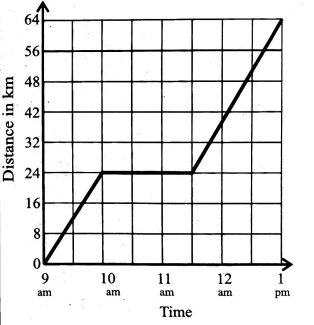
Calculate his average speed for the whole journey.- 64 km/h
- 8km/h
- 16km/h
- 12km/h
MARKING SCHEME
- B
- B
- A
- B
- B
- D
- D
- A
- C
- C
- C
- D
- C
- C
- C
- D
- C
- B
- C
- B
- A
- B
- B
- A
- B
- C
- B
- B
- D
- C
- C
- D
- A
- B
- D
- D
- C
- B
- A
- B
- B
- C
- A
- B
- B
- B
- D
- D
- A
- C
Social Studies & Religious Education Questions and Answers - Class 8 End Term Exams Term 2 2023 Set 1
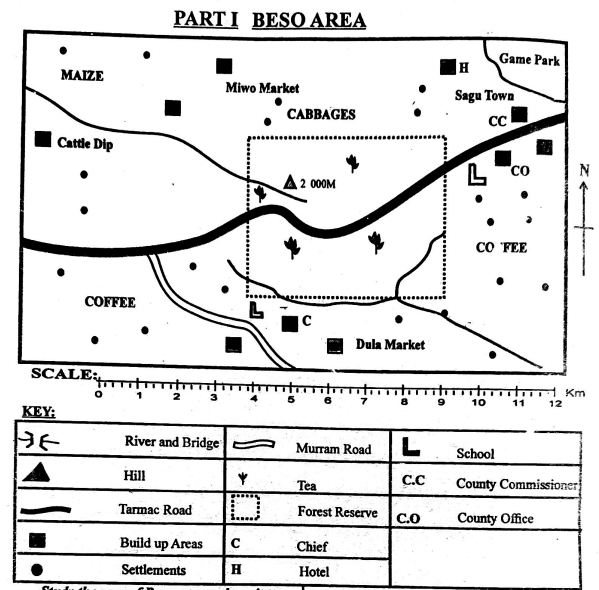
Study the map of Beso area and use it to answer questions 1 to 7.
- The highest part of Beso area is in the
- central region.
- game park.
- west.
- east.
- The main reason why Beso area has a high population is that the area has
- adequate rainfall.
- good roads.
- several trading centres.
- gently sloping land.
- A forest reserve was established in Beso area mainly to
- provide timber in the area.
- make the landscape beautiful.
- provide shade to tea bushes.
- preserve water catchment areas.
- Which one of the following offices in the area covered by the map issues trading licences?
- Chief's office.
- County commissioner's.
- County office.
- Governor's office.
- Tea is grown in the central part of Beso area because
- there are cool and wet conditions.
- there are good roads to transport tea.
- rivers provide water for irrigation.
- the area is hilly.
- Which one of the following economic activities is not carried out in Beso area?
- Trading
- Lumbering
- Tourism
- Transport
- The administrative head of Beso area is
- an assistant county commissioner.
- a county commissioner.
- a governor.
- a chief.
- Before the coming of Europeans, decisions among the San people were made through
- consensus.
- chiefs.
- council of elders.
- kings.
- Which one of the following is a responsibility of children in a family?
- Providing land to build a family house.
- Providing security in the family.
- Taking care of family property.
- Providing basic needs.
- Which one of the following traditional weather observation methods indicates the approach of a wet season?
- Grass turning brown.
- Appearance of locusts.
- Absence of dew on the grass.
- Growing of new leaves on plants.
- The Agiriama people were defeated by the British mainly because
- the Agiriama used inferior weapons.
- the British had a large army.
- Agiriama leaders were arrested.
- other communities did not support the Agiriama.
- Large urban centres in Germany are densely populated because
- rural areas are dry.
- most people are educated.
- many people work in towns.
- most families are small.
- Which one of the following groups is made up of communities that migrated from Bahr -el-Ghazal region?
- Abagusii, Abakuria, Abaluhyia.
- Taita, Pokomo, Mijikenda.
- Maasai, Iteso, Karamajong.
- Luo, Acholi, Dinka.
- Most settlement schemes in Kenya are found in the highland regions because
- the areas have good roads.
- the areas had been taken by white settlers.
- the areas receive high rainfall.
- cash crops are grown in the areas.
- A school motto is important because it
- guides learners to achieve school aims.
- outlines school rules.
- allocates time for school activities.
- shows direction to a school.
- The diagram below represents a marine fishing method.
The fishing method shown above is- trawling.
- net drifting.
- purse seining.
- long lining.
- Which one of the following pre-historic sites is found in Uganda?
- Fort Ternan.
- Merowe
- Lalibela.
- Ishango.
- Which one of the following groups is made up of Bantu communities found in Central Africa?
- Baganda, Basoga, Batoro.
- Zulu, Venda, Xhosa.
- Balunda, Chewa, Lozi.
- Chagga, Hehe, Nyamwezi.
- Age groups in traditional African communities are made up of people
- who have a common ancestor.
- who speak the same language.
- initiated about the same time.
- who live in the same area.
- The government of Botswana helps pastoral communities in the country through
- giving them loans to buy cattle.
- drilling boreholes in pastoral areas.
- irrigating pasture in grazing areas.
- giving pastoralists animal feeds.
- In Kenya human rights can be abused in the following ways except
- arresting suspected criminals.
- dispersing peaceful demonstrations.
- beating suspected criminals.
- engaging children in hard labour.
- The political party that led Ghana to independence was
- United Gold Coast Convention (UGCC).
- Northern Peoples Party (NPP).
- African National Congress (ANC).
- Convention Peoples Party (CPP).
- Three of the following factors may lead to slow population growth in a country. Which one may not?
- Practice of family planning methods.
- Late marriages.
- Practice of polygamy.
- Decrease in food production.
- Practice of shifting cultivation has decreased due to
- decrease in rainfall.
- decrease in soil fertility.
- inadequate farming equipment.
- increase in population.
- The natural forests along the coast in Kenya are preserved mainly because they
- have rare indigenous trees.
- are sources of rivers.
- provide timber for export.
- produce pulp for paper making.
- Which one of the following statements about assembling industries in Kenya is true? They
- mainly use imported materials.
- are found in rural areas.
- employ most people.
- mainly produce goods for export.
- The judicial system in Kenya is headed by the
- President.
- Chief justice.
- Attorney General.
- Speaker.
- Which one of the following is not a function of a clan?
- Maintaining clan traditions.
- Allocating land to clan members.
- Settling disputes among members.
- Getting marriage partners for members.
- Most mountains on the floor of the Rift Valley were formed through
- faulting.
- erosion.
- volcanicity.
- folding.
- The Bantu people migrated from the Congo Basin mainly due to
- search for better farming lands.
- attacks by the Galla people.
- low rainfall in the area.
- search for better grazing lands.
- The main forms of transport used to distribute petroleum products in Kenya are pipeline and
- water.
- air
- railway.
- road.
Use the map of Kenya below to answer questions 32 to 35.
- Which one of the following statements about the communities that used the route marked Z during migration is false? They
- practised fishing.
- were escaping from Galla raids.
- settled around lake Victoria.
- spoke a Nilotic language.
- The method used to extract the mineral mined at the place marked T is
- opencast
- scooping.
- dredging.
- evaporation.
- Three of the following statements about the town marked S are true. Which one is not? It
- started as a colonial post.
- is Kenya's main seaport.
- was visited by early visitors.
- has a petroleum refinery industry.
- The lake marked M is lake
- Nakuru.
- Baringo
- Elementaita.
- Naivasha
- Three of the following are problems facing dairy farming in Kenya. Which one is not?
- Delays in transporting mil.
- Inadequate pasture in the dry season.
- Poor prices for milk to farmers.
- Inadequate labour in dairy farms.
- The colonial policy used by the French to administer Senegal was
- direct rule.
- assimilation
- indirect rule.
- paternalism.
- Which one of the following dams was mainly constructed to store water for irrigation?
- Aswan High Dam.
- Akosombo Dam.
- Masinga Dam.
- Kariba Dam.
- Which one of the following factors may undermine peace in urban centres?
- Competition for pasture.
- High rates of unemployment.
- Differences in cultural practices.
- High levels of illiteracy.
- The main benefit of Jua Kali industries is that they
- produce goods for export.
- make use of idle lands.
- provide employment.
- make use of imported raw materials.
- Who among the following prominent African leaders was not a founder member of the Organization of African Unity (OAU)?
- Leopold Sedar Senghor.
- Gamal Abdel Nasser.
- Haile Selassie.
- Nelson Mandela.
- Which one of the following rivers is correctly matched with the water body where it drains into?
- River Omo - Indian Ocean
- River Nzoia - Lake Victoria
- River Nile - Lake Turkana
- River Zambezi - Mediterranean Sea
- The two countries connected by the Trans African Highway are
- South Africa and Egypt.
- Nigeria and Algeria.
- Benin and Morocco.
- Kenya and Nigeria.
- A similarity in the population of Kenya and India is that in both countries,
- most people live in rural areas.
- there are more males than females.
- life expectancy is over 80 years.
- families are mainly small.
- The title of the traditional leader of the Maasai people in the pre-colonial period was
- Nabongo.
- Laibon.
- Orkoiyot.
- Sakawa.
- The headquaters of the Southern African Development Community (SADC) are in
- Arusha in Tanzania.
- Lusaka in Zambia.
- Pretoria in South Africa.
- Gaborone in Botswana.
- Flower farmers in Kenya are able to grow them throughout the years because they
- are grown in greenhouses.
- are grown in high rainfall areas.
- are in great demand.
- have a ready market.
- Which one of the following is the most effective method of ensuring discipline among pupils in a school?
- Punishing pupils who misbehave.
- Making rules for pupils to follow.
- Promoting dialogue.
- Sending away indisciplined pupils.
- Three of the following are principles of democracy. Which one is not?
- People elect leaders of their choice.
- Citizens are involved in decision making.
- There is respect for human rights.
- Citizens are exempted from taxes.
- The amount of water vapour in the air is measured using
- a barometer.
- a hygrometer.
- an anemometer
- a thermometer.
- A contribution of Julius Nyerere in promoting peace in Eastern Africa was that he
- chaired peace talks in Burundi.
- promoted the use of Kiswahili.
- established Ujamaa Villages.
- supported liberation movements.
- Which one of the following factors does not influence the climate of a place?
- Relief
- Altitude
- Longitude
- Latitude
- Rural to rural migration in Kenya is mainly caused by
- retirement from employment.
- search for trade goods.
- search for employment.
- search for better farming land.
- Oxbow lakes are formed through
- deposition.
- erosion.
- faulting.
- volcanicity.
- Farmers in the highland regions of Kenya grow tea in small farms because of
- scarcity of labour.
- scarcity of tea factories.
- scarcity of farming land.
- high cost of growing tea in large farms.
- The main tourist attraction in the islands of Mauritius is
- snow-capped mountains.
- coastal beaches.
- pyramids.
- pre-historic sites.
- When the Nandi people resisted British colonial rule in Kenya, they were led by
- Koitalel arap Samoei.
- Mukite wa Nameme.
- Waiyaki wa Hinga.
- Mekatilili wa Menza.
- Which one of the following groups is made up of the most important imports in Eastern Africa?
- Fertilizers and livestock.
- Petroleum and machinery.
- Textiles and canned foods.
- Flowers and tea.
- In Kenya, implementation of government policies is done by the
- executive.
- judiciary.
- legislature.
- senate.
- A foreigner is allowed to register as a Kenyan citizen if the person has continuously lived in Kenya for
- two years.
- four years.
- seven years.
- five years.
PART II
SECTION A
CHRISTIAN RELIGIOUS EDUCATION
- Which one of the following statements describes why human beings are special in God's creation? They were
- placed in the garden of Eden.
- the last to be created.
- created from the soil.
- created in the image of God.
- The main reason why God saved Noah and his family from the flood was that Noah
- was an old man.
- lived a holy life.
- accepted to build the ark.
- was a priest.
- At which one of the following places did Jacob see a staircase of angels in a dream?
- Moreh
- Peniel
- Shechem
- Bethel
- Which one of the following was a reason why the Israelites ate unleavened bread before they left Egypt?
- There was no yeast in Egypt.
- They were celebrating the Passover.
- They were in a hurry to leave Egypt.
- They wanted to remember their suffering.
- Which one of the following commandments did the Israelites break when Aaron made a golden bull calf?
- "Worship no other god but me"
- "Do not accuse anyone falsely"
- "Do not commit murder"
- "Keep the Sabbath day Holy"
- Who among the following women was a judge in Israel?
- Ruth
- Naomi
- Deborah
- Miriam
- Which one of the following was done by Samuel when he was the king of Israel? He
- consulted a Median.
- took Naboth's vineyard.
- took the wife of Uriah.
- built a temple in Jerusalem.
- Naboth was stoned to death mainly because
- false accusations were brought against him.
- Jezebel hated him.
- he had refused to sell his vineyard to Ahab.
- he had committed adultery.
- The triumphant entry of Jesus to Jerusalem riding on a donkey had been prophesied by
- Micah
- Zechariah.
- Hosea
- Joel.
- Which one of the following was done by the wisemen when they saw baby Jesus? They
- went to tell Herod.
- gave Him clothes.
- asked Jesus' parents questions.
- presented gifts to Him.
- Who among the following people described Jesus as the light of the Gentiles during the presentation?
- Simeon.
- Zechariah
- Anna
- Elizabeth
- When some soldiers went to John the Baptist, he advised them to
- respect the Jewish law.
- observe the Sabbath.
- be contented with their pay.
- obey the Roman rulers.
- When Jesus changed water into wine, He had gone to Cana to
- visit His relatives.
- preach in the synagogue.
- attend the Passover feast.
- attend a wedding.
- The main lesson Christians learn from the miracle of healing of the Roman Centurion's servant is that Jesus is
- a universal Saviour.
- our father
- a healer.
- all knowing.
- Which one of the following parables did Jesus teach while seated in a boat
- The mustard seed.
- The sower.
- The ten young women.
- The widow and the judge.
- The people who took Jesus to the high priest accused Him of
- mixing with sinners.
- refusing to pay taxes.
- claiming to destroy the temple.
- working on a Sabbath.
- On the day Jesus resurrected, He first met and spoke to
- Mary Magdalene.
- Salome.
- Joanna.
- Cleopas.
- On the day of Pentecost, the disciples were in a locked room because they were
- waiting for the Holy Spirit.
- afraid of the Jews.
- praying and singing.
- sleeping.
- Which one of the following miracles was performed by Peter in Lydda? He
- raised Tabitha.
- healed a lame beggar.
- raised Eutychus.
- healed Aeneas.
- Who among the following believers was chosen by the disciples as a deacon?
- Paul
- Barnabbas
- Phillip
- Matthias
- Which one of the following is a fruit of the Holy Spirit?
- Faith
- Wisdom
- Healing
- Love
- Who among the following specialists in traditional African Communities leads people in offering sacrifices?
- Diviners
- Priest
- Herbalist
- Rainmaker
- People share resources in traditional African communities in order to
- use surplus resources.
- be recognized in the society.
- show concern for others.
- be rewarded.
- A common practice during marriage in both Christianity and traditional African communities is
- blessing the couple.
- offering sacrifices.
- exchanging vows.
- eating sacrificial meals.
- Blood that is shed during initiation in traditional African communities indicates
- that the initiate are brave.
- the value of responsibility.
- a change from childhood.
- union with ancestors.
- Peter hides in the toilet when other pupils are cleaning their classrooms. The best action for you to take is to
- report him to the teacher on duty.
- get another pupil to work for him.
- tell him to work with other pupils.
- report to his parents.
- The element of prayer when a person prays for his needs is
- confession.
- adoration.
- Petition.
- Intercession.
- In Kenya, the church has established health facilities in order to
- provide free treatment.
- create jobs in the country.
- get money to build churches.
- promote good health among people.
- Christian youth can spend their free time serving the community by
- attending birthday parties.
- cleaning market streets.
- singing in the church choir.
- playing football.
- Thika School for the Blind was started by
- Salvation Army Church.
- Catholic Church.
- Methodist Church.
- African Inland Church.
SECTION B:
ISLAMIC RELIGIOUS EDUCATION
- Muslims are commanded over two pillars in surah Bayyina, as they usually follow each other in the Holy Qur'an. Which ones?
- Perform prayers and give out zakat.
- Fear Allah and the day of judgement.
- Fast swaum and go for Hajj.
- Respect Allah and do good to parents.
- Allah (s.w) created man in the best mould and then reduced him to the lowest of low, as stated in surah Tiin. This could be due to his
- forgetfulness.
- weakness.
- immorality.
- mortality.
- What was the prophet reminded to do in surah Dhuha with the many favours that Allah (s.w) blessed Him with?
- To make others rich.
- To do good with them.
- Distribute them to the needy.
- Take them out.
- The historical event that makes Lailatul Qadr better than 1 000 months is the
- descending of angels.
- revelation of the Holy Qur'an.
- prevailing of peace until fajr.
- way Ruh accompanies other angels.
- Which among the following forms of ikhlas is the subject matter in surah Ahad?
- Reliance on Allah.
- Fear of Allah.
- Omnipresence of Allah.
- Monotheism of Allah.
- The prophet (p.b.u.h) said that _____________________pinches the mind and you do not want people to know about it.
- virtue act.
- vice act.
- doubtful act.
- strange act.
- The following people fall in the trap of those facilitating bribe except the one who
- receives it
- mediates it.
- hates it.
- writes its contract.
- In which pillar of swalah is Tashahhud recited? In
- sujud.
- julus.
- qiyam.
- rukuu.
- The two parts of the body dusted during Tayammum are
- nose and ears.
- feet and head.
- neck and chest.
- face and arms.
- Which of the following fardh salaats have no sunna baadiya after them?
- Dhuhr and Maghrib.
- Maghrib and Isha.
- Fajr and Asr.
- Isha and Fajr.
- Which one of the following is a condition for fasting? One must be
- a praying Muslim.
- a free citizen.
- in good health condition.
- a Muslim.
- Which act in Taraweh sunna prayer makes it to be called "Taraweh"?
- There is a pause after every two rakaats.
- It is only performed once in a year.
- It is performed during the fasting month.
- It is performed by reciting the whole Qur'an.
- All the following ibaadaats in Hajj are performed seven times except
- sa'y.
- twawaf.
- ram-yul jimaar.
- drinking from zamzam.
- Muslims who arrive in Makka for Hajj ibaada utter acceptance recitation called
- talbia.
- tahniq.
- takbir.
- tash-kur.
- Which of the following is not a pillar included in salaat janaza?
- A niyyat
- Qiyan
- Sujuud
- Surah Fatiha
- The imam leading a congregation in salaat janaza for a dead woman should stand around the _________________ of the body.
- head
- feet
- waist
- chest
- Muslims who do not practise the five daily salaats are
- breaking the religion.\
- joining half the religion.
- not together with others.
- not true Muslims.
- Which type of wisdom shall a Muslim apply in a situation where he is required to think on his own before acting?
- Ijma
- Qiyas.
- Qur'an.
- Hadith.
- The measure of water that cannot be dirtified hence remains clean for ablution is called
- Nisab.
- Qiratuu.
- Shibr.
- Qulatein.
- All the rituals performed for the dead are in the Islamic sharia classified as
- Sunna Muaqada.
- Fardh kifaya.
- Mustahabbu.
- Fardh Ain.
- Which among the following dates of the month is a yaumul abyath?
- 1st
- 10th
- 27th
- 15th
- On which day of the week are Muslim deeds written by angels Raqib and Atid and raised to the Arsh of Allah? On
- Monday.
- Thursday.
- Saturday.
- Friday.
- Which one of the following is the most pleasing act before Allah?
- Giving out salaams among Muslims.
- Having self control
- Kindness in what we do.
- Swalah in correct time.
- Why should a Muslim judge hear from both sides of difference?
- For him to advise and give a warning.
- To have an accurate punishment.
- To administer revenge.
- To give justice.
- It is true to say that nabii Yusuf went to prison because of
- raping Potiphar's wife.
- explaining the meanings of his drearms.
- the fitna of Potiphar's wife.
- worshipping idols.
- All the following things were instrumental in the spread of Islam along the coast except
- Islamic culture.
- trade.
- intermarriage.
- Portugal rule.
- According to the belief in Islam on “ihsan”, Allah (s.w) is___________________________ everyone wherever he or she is.
- providing for
- guiding
- hearing
- seeing
- The main reason why Allah (s.w) prohibited Muslims to use intoxicants is because they
- destroy the body health.
- have social effects.
- lead to other evils.
- are handworks of sheitwan.
- The main reason why Allah (s.w) commanded the rich to pay zakat is to protect the poor from
- shame.
- suffering.
- begging.
- gambling.
- In which of the following places do the Muslims on Hajj ibaadah perform the rite of sacrificing animals? At
- Muzdalifa.
- Minna.
- Aqaba.
- Arafa.
MARKING SCHEME
SOCIAL STUDIES
- A
- A
- D
- C
- A
- B
- B
- A
- C
- D
- A
- C
- D
- B
- A
- B
- D
- C
- C
- B
- A
- D
- C
- D
- A
- A
- B
- D
- C
- A
- D
- B
- C
- A
- B
- D
- B
- A
- B
- C
- D
- B
- D
- A
- B
- D
- A
- C
- D
- B
- A
- C
- D
- A
- C
- B
- A
- B
- A
- C
C.R.E
- D
- B
- D
- C
- A
- C
- A
- C
- B
- D
- A
- C
- D
- A
- B
- C
- A
- B
- D
- C
- D
- B
- C
- A
- D
- C
- C
- D
- B
- A
I.R.E
- A
- C
- D
- B
- D
- B
- C
- B
- D
- C
- A
- B
- D
- A
- C
- D
- A
- B
- D
- D
- D
- C
- B
- A
- C
- B
- D
- D
- B
- B
Science Questions and Answers - Class 8 End Term Exams Term 2 2023 Set 1
QUESTIONS
- Which one of the following is not a function of the placenta?
- Supplies food from the mother's blood to the foetus.
- Produces hormones that stop pregnancy.
- Facilitates the transfer of waste products from the foetus to the mother.
- Allows exchange of oxygen and blood from the mother to the foetus.
- The diagram below shows a type of human tooth.
The function of the tooth is- chewing and grinding.
- cutting and biting.
- gripping and tearing.
- grinding and cutting.
- Which one of the following pairs of parts of the breathing system is involved in cleaning and warming the air?
- Nose and trachea.
- Nose and lungs.
- Diaphragm and trachea.
- Lungs and diaphragm.
- Oxygenated blood from the lungs enters the heart through the
- aorta.
- pulmonary artery.
- venacava.
- pulmonary vein.
- A weed has the following characteristics:
- Has thorns on the stem.
- Produces purple and white flowers.
- Grows in semi-arid areas.
The weed is likely to be- mexican marigold.
- pigweed.
- sodom apple.
- black jack.
- Which pair of plants below depends on animals for food?
- Mushroom and algae.
- Sundew and toadstool.
- Pitcher plant and venus fly trap.
- Mushroom and toadstool.
- Grade four pupils classified crops using a simple chart as shown below.
Which one of the following pairs of plants represents X and Y respectively?- Wheat and groundnuts.
- Peas and maize.
- Rice and greengrams.
- Groundnuts and peas.
- Which one of the following groups consists only of field pests?
- Aphids, weaver birds, white ants.
- Weevils, white ants, stalkborers.
- Weevils, aphids, weaver birds.
- Aphids, weaver birds, cutworms
- Which pair of plants below stores food in the stems?
- Arrowroots and cassava.
- Cassava and carrot.
- Yams and arrowroots.
- Sugarcane and irish potato.
- The following are characteristics of a certain vertebrate:
- Varying body temperature.
- Has internal fertilization.
- Breathes through lungs.
- Body covered with scales.
Which vertebrate is being described above?- Hawk.
- Nile perch
- Turtle
- Whale
- Which one of the following feeding adaptations of herbivores is not correct?
- Continuous replacement of molars and pre-molars replaces the worn out teeth due to constant grinding.
- The horny pad on the lower jaw holds food tightly against incisors while cutting grass.
- Molars and pre-molars are used for grinding, crushing and chewing.
- The toothless gap between incisors and pre-molars is used for turning vegetable materials for proper chewing.
- Which pair of birds feeds on the same type of food?
- Hawk and sunbird.
- Weaver bird and hen.
- Flamingo and eagle.
- Chicken and sunbird.
- Grade five pupils set the experiment shown below.
Heat was transferred from W to Y through- convection, conduction.
- conduction, convection.
- conduction, radiation.
- convection, radiation.
- The following are maintenance practices carried out on simple tools. Which one of them is not carried out in all tools?
- Cleaning tools after use.
- Sharpening cutting edges.
- Proper use of tools.
- Proper storage.
- The diagram below was an activity carried out by Grade 6 pupils during a Science lesson.
The properties of light the learners were investigating are- bending of light and bouncing of light.
- bouncing of light and splitting of light.
- bending of light and absorption of light.
- bending of light and splitting of light.
- Which one of the following is not a source of electricity?
- Solar panel.
- Biogas plant.
- Windmill generator.
- Bicycle dynamo.
- Grade five pupils were using a simple seesaw to balance two objects as shown below.
In order for both objects to balance,- object J should be moved towards the pivot.
- object K should be moved away from the pivot.
- move the pivot towards object J.
- move the pivot towards object K.
- Which one of the following is an example of a transluscent material?
- Mirror.
- Oiled paper.
- Clear water.
- Kerosene.
- Which one of the following is a safety measure against lightning?
- Carrying pointed objects when it is raining.
- Leaning on the wall.
- Avoiding open grounds when it is raining.
- Walking and playing in pools of water when it is raining.
- Which one of the following does not help in reducing the force that hinders motion?
- Applying adhesives.
- Streamlining bodies.
- Using rollers.
- Using oil and grease.
- The diagram below shows the arrangement of load, effort and fulcrum in a simple lever.
Which of the following levers has the same arrangement as the one shown above?- Spade
- Crowbar
- Wheelbarrow
- Claw hammer.
- Which of the following parasites destroys wool in sheep?
- Lice
- Fleas
- Mites
- Ticks
- A patient was diagnosed with the following signs and symptoms:
- Swelling of the lymph glands.
- Skin wounds and ulcers on penis and rectum.
- Painful regular sore.
Which sexually transmitted infection was he suffering from?- Gonorrhoea.
- Syphilis
- HIV/AIDS
- Chancroid
- Which one of the following consists only of farm animals that produce mutton?
- Goats and pigs.
- Sheep and cows.
- Cows and goats.
- Sheep and goats.
- A person infected with HIV/AIDS will look healthy and strong but test positive. The person is likely to be at what stage of HIV infection?
- Window
- Symptomatic.
- Asymptomatic.
- Full blown.
- Which one of the following communicable diseases destroys the red cells?
- Tuberculosis.
- Malaria
- Typhoid.
- Bilharzia.
- Which one of the following is the best advice to a person experiencing bleeding gums?
- Avoid sugary food substances.
- Change the toothbrush and toothpaste regularly.
- Visit a dentist as soon as possible.
- Eat a diet rich in fruits and vegetables.
- Which one of the following is not a sign of kwashiorkor?
- Swollen limbs and stomach.
- Crying often.
- Brown and loose hair.
- Potbelly.
- Which of the following shows effects of bhang?
- Breathing problems and memory loss.
- Drowsiness and vomiting.
- Addiction and lack of sleep.
- Hallucination and addiction.
- Which one of the following is the main reason why nursing mothers should feed on a diet rich in iron? In order to
- get energy to breastfeed the baby.
- repair worn out tissues.
- strengthen and recover bones and teeth.
- replace blood lost during birth.
- Which of the following foodstuffs does not constitute a balanced diet?
- Chapati, greengrams, cabbage.
- Rice, meat stew, spinach.
- Ugali, termites, kales.
- Milk, bread, sausage.
- The type of clouds which indicates fine weather has the following characteristics except
- having flat bottoms.
- being white in colour.
- appearing high in the sky.
- looking like mountains.
- The diagram below shows a weather instrument.
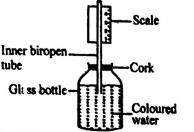
Which of the following statements is not true? The- scale reads from top to bottom.
- coloured liquid is used to enhance visibility.
- inner biropen tube is narrow to increase efficiency.
- instrument is placed in a place with free air movement.
- Which pair of planets consists of the inner planets only?
- Earth and Mars.
- Jupiter and Neptune.
- Venus and Mars.
- Mercury and Venus.
- Which one of the following pairs of animal feeds would provide an animal with fats, oils and vitamins?
- Lucerne and grass.
- Fishmeal and desmodium.
- Oats and concentrates.
- Rice husks and fruits.
- Which two components of the environment are involved in the carbon cycle?
- Plants and water.
- Soil and air.
- Plants and animals.
- Air and plants.
- Excess use of inorganic fertilizers pollutes
- soil only.
- water only.
- water and soil.
- air and water.
- Which one of the following need not be the same when comparing how water rises in different soils?
- Size of cotton wool.
- Amount of soil.
- Diameter of the tubes.
- Type of soil.
- The diagram below was used as an experiment to investigate a certain property of matter.
While investigating, the teacher held the bottle with both hands. The drop of ink was seen moving upwards. This shows that- solids expand when heated.
- liquids expand when heated.
- gases expand when heated.
- both liquids and gases expand when heated.
- A pupil mixed water, spirit, kerosene and cooking oil in one transparent bottle. How many layers were formed?
- 1
- 2
- 3
- 4
- The diagram below shows the composition of air
Which component can be used to put out a burning candle?- W
- X
- Y
- Z
- Which one of the following mixtures cannot be separated using a magnet?
- Small sticks and staple pins.
- Iron filings and maize flour.
- Thumb pins and steel nails.
- Copper filings and staple pins.
- Two plastic lids of equal sizes are placed on water in a basin. Four small stones are placed on one lid and it sank while the other lid floated. This shows that
- shape affects sinking and floating.
- mass affects sinking and floating.
- material affects sinking and floating.
- size affects sinking and floating.
- Which one of the following is a compound fertilizer?
- Muriate of potash.
- Ammonium sulphate nitrate.
- Double superphosphate.
- Diammonium phosphate.
- Pupils of Grade 4 carried out the activity shown below
The pupils concluded that soil has- organic matter.
- water.
- mineral particles.
- air.
- Draining stagnant water can prevent the spread of
- cholera and typhoid.
- cholera and bilharzia.
- typhoid and malaria.
- bilharzia and malaria.
- Which one of the following statements is correct about water?
- Filtration makes water safe for drinking.
- Boiled hard water is safe for drinking.
- Soft water should not be boiled before drinking.
- Boiling makes hard water difficult to lather.
- Which one of the following uses of water is not practised in the farm?
- Mixing chemicals.
- Washing toilets.
- Cleaning implements.
- Irrigation.
- Mopping the floor using water left from laundry is
- recyling water.
- using water sparingly.
- reusing water.
- water harvesting.
- The diagram below shows a type of soil erosion.

This type of erosion- occurs in gentle slopes.
- occurs without being noticed.
- develops from rills.
- can be prevented by planting grass.
MARKING SCHEME
- D
- A
- A
- D
- C
- C
- B
- D
- D
- C
- B
- B
- B
- B
- D
- B
- D
- B
- C
- A
- C
- C
- D
- D
- C
- B
- D
- B
- D
- D
- D
- D
- A
- D
- C
- C
- C
- D
- C
- B
- C
- C
- B
- D
- D
- D
- B
- B
- C
- C
Kiswahili Questions and Answers - Class 8 End Term Exams Term 2 2023 Set 1
Soma vifungu vifuatavyo. Vina nafasi 1 mpaka 15. Kwa kila nafasi umepewa majibu manne hapo. Chagua jibu lifaalo zaidi kati ya uliyopewa.
__1__ husema kuwa __2__. Ulimi huu ulidhihirika __3__ hivi majuzi humu nchini pale ambapo mchungaji mmoja maarufu aliwahadaa wafuasi wake kwa kuwaagiza kususia chakula na maji kwa muda wa siku arubaini ili kumwona Mungu. Hatua hii __4__ mauti ya wengi wa wafuasi hao wake huku miili yao ikipatikana katika shamba la mchungaji huyo la zaidi ekari themanini. Iliaminika kuwa mchungaji huyo alikuwa na nia __5__ ambayo haikubainika kwa wakati ufaao. Wengi walisikika wakidai kuwa kuwaamini baadhi ya wachungaji sasa ni sawa na __6__. Baadhi hawaaminiki. __7__.
| A | B | C | D | |
| 1. | wasemavyo | waemayo | wasemao | wanaposema |
| 2. | kosa moja halimwachishi mke | papo kwa papo kamba hukata jiwe | papo kwa papo kamba hukata jiwe | uzuri wa kuyu ndani mabuu |
| 3. | tenge tahanani | dhahiri shahiri | daima dawamu | liwalo na liwe |
| 4. | ilipelekea | ilielekeza | ilileta | ilisababisha |
| 5. | fiche | bora | bayana | njema |
| 6. | kutarajia manufaa baada ya bidii | kuchezea shilingi katika tundu la choo | kuwarai waumini kujiunga na madhehebu | kumtegemea Mungu katika shughuli zetu |
| 7. | Wamevalia ngozi ya chui | Wamezifichua kucha zao | Wamevalia ngozi ya kondoo | Matendo yao yako wazi |
Dunia ya sasa inaenda mbio na maisha ya vijana wetu nayo pia __8__ kwa kiasi mithili ya duma. Ugumu wa maisha na __9__ kwa uchumi vinawasukuma baadhi yao __10__ katika uhuni ili __11__. Ni afadhali __12__ na kidogo walicho nacho kuliko kutamani kingi wasicho nacho kwani __13__. Pia, wanaweza kujianzishia miradi ya __14__ badala ya __15__.
| A | B | C | D | |
| 8. | yakitimika | yakiimarika | yakizorota | yakidumaa |
| 9. | kuporomoka | kujengeka | kubomoka | kuimarika |
| 10. | kujitoma | kujiondoa | kujitosa | kujikuta |
| 11. | kusaka ukata | kusumbua riziki | kuasi umaskini | kutafuta umaarufu |
| 12. | watosheleza | wasiridhike | wakinaishwe | wasikinai |
| 13. | haba na haba hujaza kibaba | apelekaye mkono kutamalaki si kazi | bura yangu sibadili na rehani | njia mbili zilimshinda fisi |
| 14. | kutusaidia | kuniauni | kujikimu | kukuokoa |
| 15. | kujikaza kisabuni | kuuma uzi | kujifunga kibwebwe | kupakata mikono |
Kutoka swali la 16 hadi 30, jibu swali kulingana na maagizo.
- Chagua sentensi iliyo na tashbihi jozi.
- Dada yake ana maringo kama tausi.
- Rudisha ana mbio mithili ya duma.
- Bahasha yangu ni nyeupe ja theluji.
- Wanafanana kama kurwa na doto.
- Tumia sifa "geni" kusanifisha sentensi ifuatayo;
Wazo alilotoa kuhusu nchi yake ni- ngeni.
- mgeni.
- ligeni.
- geni.
- Chagua ala ya muziki ambayo huchezwa kwa uta mdogo.
- Firimbi
- Zeze
- Marimba
- Zumari
- Kiulizi "ngapi" huwa tasa katika ngeli gani?
- I - ZI
- LI-YA
- KI-VI
- KU-KU
- Tenga silabi katika neno "mafunzo"
- m-a-f-u-n-z-o
- ma- fu- n - zo
- mafunzo
- maf - un-zo
- Kamilisha methali;
Kukopa harusi- isiyo na vigelegele.
- ingawa kulipa ni kugumu.
- kulipa matanga.
- lakini hakuna raha,
- Chagua sentensi iliyo sahihi kisarufi.
- Wewe na Musa ndio viranja wa darasa letu.
- Utajua aje hesabu bila kufanya mazoezi?
- Upande huu ni mpana kuuliko ule.
- Kwamba atakuja au atasusia, kwangu ni mmoja.
- Je, ni sentensi ipi iliyotumia kiunganifu-a- kwa usahihi?
- Rafiki ya Abdala ni Salim.
- Katikati mwa jiji kuna msongamano wa magari.
- Uwanjani kwa watoto kuna nyasi ndefu.
- Shauri ya Omari, hakumaliza kazi ya mwalimu.
- Chagua orodha yenye vivumishi pekee.
- Yangu, kivivu, yeye, juu ya
- Lini, ovyo, ya, ala!
- Pona, ona, safi, ghali.
- Wao, hiki, nyembamba, mwa
- Chagua maneno yaliyo katika ngeli ya I-ZI.
- Dahalia, korti, kawa.
- Maabara, kalamu, chupa.
- Maeneo, mizani, simu.
- Kimbilio, maskani, nyumba.
- Nomino kudhoofika lina konsonanti ngapi?
- 4
- 5
- 3
- 6
- Eleza matumizi ya “na”
Wana huzuni tangu wafiwe na mkoi wao.- Umiliki
- Mtendaji
- Hali
- Kiunganishi
- Ni sayari gani kati ya hizi iliyo angavu zaidi?
- Mshtarii
- Zuhura
- Utaridi
- Zohali
- Nahau enda magamaga ina maana ya
- enda kwa kutanua miguu.
- aga dunia.
- enda upesi.
- tembea polepole.
- Kimelea gani hupatikana katika maskani ya kuku?
- Siridado
- Funza
- Papasi
- Utitiri
Soma kifungu kifuatacho kisha ujibu maswali 31 hadi 44.
Ukistaajabu ya Musa utayaona ya Firauni. Rafiki yangu, Bwana Kenzi almaarufu "mkereketwa❞ alihitaji tuonane uso kwa macho katika eneo la Shambahola siku mbili tatu zilizopita. Maadamu nilikuwa waya, sikuwa na budi ila kuhesabu hatua kuanzia kwangu hadi alipokuwa Kenzi. Si mtu hujikuna ajipatapo bwana!
Njiani walikuwapo wale ndugu zetu wanaoishi na ulemavu wakiwa katika hamsini zao za kuomba chochote kutoka kwa wapitanjia. Wengi wa wapitanjia waliwavalia miwani na kuendelea na shughuli zao za ujenzi wa taifa. Nilipowatazama, niliwahurumia na kuwasikitikia. Vitoto vyao je? Maskini, moja... mbili... tatu, mbavu hizo!
Nilifahamu kuwa sikuwa na chochote kwa hivyo, ili kuchelea kuunguzwa ndani kwa ndani, ilinipasa kukaza mwendo ili nisiwaone tena. Mara, nilikuwa nimewapa kisogo na kuyoyomea mbali. Moyoni nilijiambia kuwa iwapo Kenzi angenipa hela kidogo, ningepitia mahali pale ili angalau niwaachie kitu.
Baada ya kukinzana na misongamano ya watu na magari, nilijipenyeza hadi katika lango la Shambahola nikaichomoa rununu yangu kuukuu ili nimwarifu Kenzi kuwa nilikuwa nimetia guu. Naam, sifuri, saba, mbili, mbili.... mara shwa! Yarabi! Wewe.... mwizi... mshikeni! Kaniibia simu, mwi... Ikiwa umewahi kubeba maji kwa gunia, basi unafahamu ninachomaanisha. Kumbe mzigo wa mwenzio ni kanda la usufi tu! Ama kweli, chambacho Kenzi, mjini ni shuleni.
Nilibaki nimejishika kichwa kwa mikono huku nikitweta si haba. Si lazima niandike kuwa nilikuwa nimenyong'onyea ungedhani konokono aliyenyunyiziwa chumvi. Ingawa ni muhimu sana kuyapokea yajayo, iliniwia vigumu kukabiliana na hali hiyo kwa muda huo. Nilihisi nimenyanyaswa na kuonewa pakubwa.
Haidhuru, nilipoingia Shambahola, sikuwa na jingine ila kuangazaangaza macho huku na kule kama pengine ningeangukiwa na nyota ya jaha kumwona Kenzi. Baada ya kuzurura kwa muda, nilimwona jamaa kwa mbali akinipungia mikono. Nilifurahi sana kumwona, Mbio, nilimwelekea ili nimsimulie yaliyojiri.
Nilipomaliza kumweleza yote, alicheka na kutingishika nusuru ya meno yake yaanguke kama si kule kuyashikilia kwa kiganja. Ala! Kwani nini kilichochekesha badala ya kusikitisha? Alicheka nini hasa? Baadaye alinieleza kuwa hiyo ilikuwa desturi kwa wageni mjini. Aliendelea kunifahamisha kuwa shababi huyo aliyenipokonya simu alikuwa mmoja wa wale "walemavu" .... ah
- Uhusiano baina ya Kenzi na msimulizi ni kwamba
- walikuwa ndugu wa toka nitoke.
- kulikuwa na urafiki mkuu kati yao.
- walikuwa wafanyakazi huko Shambahola.
- kulikuwa na uhasama mkuu baina yao.
- "...nilikuwa waya..." ni
- nahau inayomaanisha kuwa msimulizi hakuwa na pesa.
- istiara inayomaanisha kuwa msimulizi alikuwa mwembamba.
- msemo wenye maana kuwa ilibidi msemaji kuchukua hatua aliyoichukua.
- sitiara inayomaanisha kuwa msimulizi alikuwa mchovu.
- Msemaji alisafiri vipi hadi Shambahola? Kwa
- matwana.
- bodaboda.
- matatu.
- miguu.
- Kulingana na aya ya pili,
- wapitanjia hawakuwajali wale waliokuwa wakiomba.
- msemaji aliwahurumia bila kuwasikitikia wale ombaomba.
- baadhi ya wapitanjia walikuwa katika hali ya ulevi.
- msimulizi wetu aliwahurumia na kuwasikitikia watoto wale.
- Dondoo "moja... mbili... tatu, mbavu hizo! inatoa dhana gani?
- Mbavu za watoto wale ziliweza kuhesabika.
- Afya ya watoto wale iliyumba.
- Familia za ombaomba wale zilikuwa katika afya mbaya.
- Watoto wale walidhoofika kupindukia.
- Mwishoni mwa aya ya tatu mna dhan kuwa
- gae huwa chombo wakatiwe.
- ndo ndo ndo hujaza ndoo.
- kutoa ni moyo, usambe ni utajiri.
- ukiona vyaelea jua vimeundwa.
- Chagua kauli iliyo ya kweli kulingana na ufahamu.
- Lengo kuu la msimulizi kutoa simu ilikuwa kumwarifu Kenzi mjo wake.
- Rununu ya msimulizi haikuwa ndogo.
- Wazalendo walimsaidia msemaji katika kumkamata mkwepuzi yule.
- Watu wa Shambahola hujalishwa na matatizo ya wenzao.
- Ni hali gani iliyomwia vigumu mwandishi kukubaliana nayo? Hali ya
- kuyapokea yajayo.
- uchovu, wasiwasi na sintofahamu.
- kutafakari dhuluma aliyotendewa.
- kumsimulia Kenzi kisa kilichomkabili.
- ".... alicheka na kutingishika nusura meno yake yaanguke...."
- ni fani tu ya lugha ya kutilia chumvi.
- inamaanisha kuwa Kenzi alibahatika kwa kuwa meno yake yangeanguka.
- inatoa dhana kuwa kisa cha msemaji kilikuwa cha kuchekesha.
- ni mojawapo ya njia za kujieleza ueleweke vyema.
- "Walemavu"
- walihitaji kuonewa huruma.
- walikuwa sawa na chui ndani ya ngozi ya kondoo.
- walikuwa sawa na kuku mgeni asiyekosa kamba mguuni.
- waliwaibia watu simu, hasa wageni mjini.
Soma kifungu kifuatacho kisha ujibu maswali 41 hadi 50.
Wakazi wa mitaa ya mabanda huogelea katika bahari kubwa sana ya changamoto. Baadhi ya changamoto zinazowakabili ni zile ambazo kwa yakini, wana uwezo wa kuzisitisha. Hata hivyo zipo nyingine ambazo kwa kweli juhudi za kuzisitisha zipo nje ya uwezo wao.
Mojawapo kati ya masaibu tumbi akidi yanayowatafuna ni hali duni ya usafi. Mingi ya mitaa hii hujulikana na kutambulika katika udororaji wa viwango vya usafi humo mitaani mwao. Si siri kuwa mitaa mingi ya mabanda haina misala, hivyo, huwalazimu wenyeji kutimizia haja zao kokote, hata vyumbani mwao! Ajabu iliyoje? Haya ni baadhi ya masaibu ya vitongoji duni.
Tatizo jingine ni la ukosefu wa usalama miongoni mwa wakazi wa mitaa husika. Wananchi wengi huamini na kusadiki kuwa baadhi ya wezi na majambazi sugu ambao majina yao hugonga vichwa vya habari kila wakati huishi mumo humo mitaani mwa mabanda. Utovu huu wa usalama umekithiri kiasi cha wakazi kuishi maisha ya roho mikononi. Dua za wakazi hawa daima huwa, "Nakuche tukushukuru, ewe Manani...."
Si suala la mjadala 'uwa asilimia kubwa sana vya watoto humo mitaani haitazamiki kwa mara ya pili. Si lolote, si chochote, vimbaumbau hasa! Ni nani atajali ilhali wazazi wao hupata wajaliwalo tu na wala si watakalo? Msamiati kama sodo kwa vitoto vya kike vilivyovunja ungo humo mitaani huwa ndoto. Si ajabu kurekodi kuwa kuishi huku gizani kwa wasichana hao maskini ndiko chimbuko hasa la ongezeko la visa vya utungwaji mimba mapema.
Ni jambo la kutia simanzi sana kuona kuwa katika mitaa mingi ya mabanda, viwango vya elimu viko chini sana ikilinganishwa na maeneo mengine ya nchi. Hali hii huchangiwa na kuwa wazazi wengi humo hawana ajira za kutajika. Ni zile familia za "bora mate tumboni". Ndiyo, upo mpango wa elimu ya dezo katika shule za umma nchini. Swali ni: ikiwa ni pesa za kujipatia angalau kibaba cha unga ili kuokoa majahazi ya familia yanayozama ni kizungumkuti, seuze hiyo koto?.... Sare je?
- Mitaa ya mabanda ni sawa na
- maeneo ya umaskini.
- majumba mabovu mabovu.
- vitongoji duni.
- vijiji vinavyohangaika.
- Ni neno lipi halina maana sawa na kuzisitisha?
- Kuzikomesha.
- Kuzitamatisha.
- Kuzihitimisha.
- Kuzikatiza.
- Ni kitambulisho gani huweza kutumiwa kuijulia mitaa ya mabanda?
- Hali duni ya usafi.
- Usafi uliokithiri.
- Uchafu wa wakazi.
- Usafi wa mazingira.
- Chagua kisawe cha neno misala kulingana na habari.
- Choo.
- Mkeka.
- Mikeka.
- Vyoo.
- Kutokana na uhaba wa usalama miongoni mwa wakazi wa mitaa ya mabanda, wenyeji huishi
- katika hali ya sintofahamu.
- katika hali ya woga mwingi.
- wakiwa na wasiwasi mwingi.
- maisha ya ajabu sana.
- "...asilimia kubwa sana ya watoto humo mitaani haitazamiki kwa mara ya pili...." kwa sababu
- wanakera na kukirihi.
- wanatia aibu kwa mtazamaji.
- wanahuzunisha pakubwa.
- wao hulialia kila mara.
- Wakazi wengi wa mitaa ya mabanda ni
- walalahai.
- walalahoi.
- walalaheri.
- walanguzi.
- Mimba za mapema kwa wasichana humo mitaani huchangiwa na
- wasichana husika kutoielewa miili yao vyema.
- wasichana hao kutofahamu matumizi ya sodo.
- watoto hao wa kike kushiriki ngono kiholela.
- watoto hao wa kike kutojua namna ya kutumia sodo.
- Suala la viwango vya elimu kuwa duni humo mitaani mwa mabanda
- linafurahisha.
- linasumbua.
- linahamasisha.
- linahuzunisha.
- Wazazi huenda wasimudu karo na sare kwa kuwa
- pesa zao zatosha chakula tu.
- pesa zao zatosha sare tu.
- hawana pesa za kutosha.
- hawana pesa.
Umepewa dakika 40 kuandika insha yako.
Kamilisha insha ifuatayo kwa maneno yako mwenyewe na uifanye iwe ya kusisimua.
Si rahisi kuyasahau yaliyonikumba katika msitu wa Ngomeni. Awali, wazazi wangu walikuwa wamenikanya dhidi ya kwenda humo msituni, nami nikatia komango masikioni. Asubuhi hiyo,.............................................................................................................
MARKING SCHEME
- C
- D
- B
- D
- A
- B
- A
- A
- A
- A
- C
- C
- C
- B
- D
- D
- D
- B
- A
- B
- C
- D
- C
- D
- B
- A
- C
- B
- A
- D
- B
- A
- D
- A
- B
- C
- A
- C
- A
- B
- C
- C
- A
- D
- C
- C
- B
- A
- D
- C
English Questions and Answers - Class 8 End Term Exams Term 2 2023 Set 1
Read the passage below. It contains blank spaces numbered 1 to15. For each blank space, choose the best answer from the choices given.
When I was young, I enjoyed __1__ mother cook, especially when she was preparing my favourite omelettes. When the eggs __2__
golden, mother flipped them __3__. I was __4__. In fact, I would jump and clap my hands with glee. Once, when mother was not in, I decided to fry an egg by __5__. Having watched mother do it so many times before, I thought I __6__ go wrong. First, I washed the pan. Then I poured some oil into the pan. __7__, as the oil heated up, it splattered all over the stove. Some of it got on my face and arms and I cried out in pain. I was __8__ terrified that I did not even try to go near the pan! After what __9__ like eternity, the sizzling oil __10__ hissing. I then __11__ the stove and spent the next hour cleaning up the mess. After that incident, __12__wanted to learn cooking. Up till now, I __13__ have not learnt the art of frying __14__. I would rather help mother wash the cooking utensils, __15__.
| A | B | C | D | |
| 1. | to watch | to watching | watching | watch |
| 2. | turned | became | changed | cooked |
| 3. | away | up | off | over |
| 4. | fascinated | shocked | frightened | alarmed |
| 5. | my self | herself | myself | ourselves |
| 6. | may not | could not | cannot | will not |
| 7. | Although | Therefore | Moreover | However |
| 8. | too | very | so | such |
| 9. | seems | seen | seem | seemed |
| 10. | ceased | stop | seized | ended |
| 11. | turned down | put out | turned off | put off |
| 12. | ever | never | often | always |
| 13. | already | yet | now | still |
| 14. | something | everything | anything | nothing |
| 15. | won't she? | would I? | wouldn't I? | don't I? |
In questions 16 and 17. choose the best alternative to complete the sentences
- The number of projects in our school _____________________ increased.
- have
- were
- has
- will
- Would she have done the work
- if she was asked to?
- if she would be asked to?
- unless she was asked to?
- if she had been asked to?
In questions 18 and 19. fill in the blank spaces with the most appropriate alternative.
- It was not until the end of the term
- that the results were announced.
- than the results were announced.
- when the results were announced.
- and the results were announced.
- Playing in the sand
- it had a coin.
- a coin was found by children.
- there was a coin.
- the children found a coin.
In questions 20 to 22. choose the alternative that means the same as the underlined words.
- The drama club performed a play about drug abuse.
- put up
- set up
- put on
- put forward
- The reasons he gave don't make sense.
- make out
- come around
- add to
- add up
- The players looked forward to beginning the match.
- anticipated
- waited
- expected
- hope
In questions 23 and 24. choose the alternative that means the same as the underlined sentense.
- They should not break the law.
- They need not break the law.
- They might not break the law.
- They must not break the law.
- They ought not to break the law.
- "The earth revolves round the sun." she said.
- She said the earth had revolved round the sun.
- She says the earth revolves round the sun.
- She said the earth revolves round the sun.
- She said the earth revolved round the sun.
In question 25, choose the best arrangement of the given sentences to make sensible paragraphs.
-
- The clever bird dropped stones into the water.
- It was not possible for the bird to reach the water.
- A thirsty bird found a tall jug with some water in it.
- To the bird's delight, the water rose high enough for it to drink.
- iii, iv, i, ii
- iii, i, ii, iv
- iii, ii, i, iv
- iii, iv, ii, i
Read the passage below and answer questions 26 to 38.
"Hurry up Njambi!" My mother plodded as I hurried to tie my brand new shoes. We were going to Uhuru Park for a picnic with our family that day. I was incredibly excited because the park was so fun and also because I loved to eat! My brother, who was 11 and exactly three years older than I, was grumpy because he thought he was "too old" for family picnics. I told myself that I would never be too old for them!
Everyone boarded our grey Sienta van and we made our way across town to Uhuru Park. The Park was beautiful during the rainy season and since it was May, all the flowers were in bloom and everything smelled fresh and sweet. We gathered all our things and made our way to a nice patch of green grass perfect for a picnic. After setting everything down, we began to bond and just enjoy the serene environment.
Not long after we all busily enjoying our food when a stray dog walked by. At first no one paid any attention because we were busy enjoying ourselves and the dog probably had a home. After a while though, I noticed that the dog had been wandering back and forth, whining the entire time. It was probably lost and my heart immediately went out to him.
"Mom! Mom! Look, a lost dog!" I told my mother in a frenzy. We both began to look around to see who might have lost a dog. My other family members looked at us like we were crazy but I was so honestly worried for the poor animal. He would be so lonely and hungry out there. We decided we would hold on the dog for a while to see if anyone such as the owner came looking for him. After about thirty minutes of waiting around, we were pretty unsuccessful so we just decided on taking him home with us. At home, the dog was full of energy; probably just happy. He had shelter and a place to rest from nature.
I got to work right away, typing "LOST DOG" flyers to post around town! I even put a picture of him. I got very much into making all the posters and stuff that I completely neglected the poor dog. He kept asking me to give him attention but I was too focused on making lost dog posters for him. He was neglected because I was too excited for the wrong things! When I finished I wanted to play with the dog but he already went to sleep, and so I was very disappointed. Later on, I realized that since I neglected him, I lost a chance to have fun and play with him!
We waited for two days, hoping for the owner to call but sadly no one called. But luckily, on the third day someone finally called. My mother and I were extremely happy but slightly bittersweet that the sweet dog that we had come to love had to leave. When the next day came, we gave the dog back to the very grateful owners, who were frantic with worry when they realized their beloved dog had gone missing.
"Mom, can we please get a dog?" I begged for the next couple of weeks. She actually finally agreed and we went to pick our own furry pet! I was the happiest girl the day I got my puppy
- According to the first paragraph, the writer was
- worried.
- excited.
- eager.
- confused.
- The writer's brother was in a bad mood because
- the family was getting late for the picnic.
- picnics were for younger children.
- the writer was three years younger.
- he thought his age was too advanced for picnics.
- What made Uhuru Park very suitable for this picnic? The
- rainy season.
- look and smell of flowers.
- patch of green grass.
- delicious food.
- When did a stray dog walk by?
- After boarding the grey Sienta van.
- While they were all enjoying their food.
- Before they started having their meal.
- When they had finished their meal.
- The family did not initially pay attention to the dog because
- the dog was harmless.
- the dog had a home.
- they were occupied with eating.
- they did not own the dog.
- The phrase "My heart immediately went out to him" as used in the passage means the writer felt
- interested in the dog.
- disturbed by the dog.
- bitter with the dog.
- pity on the dog.
- The word "pretty" as used in the passage means
- beautiful.
- very
- extremely.
- fine.
- It is true to say that
- only the writer and the mother were concerned about the stray dog.
- the dog did not behave well when it went to the picnic site.
- the writer intended to steal the stray dog but changed her mind.
- it was the writer's mother who suggested they take the dog home.
- Why was the writer unable to play with the dog once they got home?
- The dog was not friendly.
- The dog was lonely and lost.
- She was worried about the dog's owner.
- She was busy putting up posters.
- The lesson the writer learnt after finding the dog already asleep was that
- neglected dogs can fall asleep.
- dogs need constant attention.
- we at times attend to the wrong things.
- we should take care of our pets.
- When finally someone called about the dog, the writer and her mother were
- disappointed.
- relieved.
- in dilemma.
- in denial.
- In the end, the writer was
- unhappy to have lost the stray dog.
- sad that the owners were ungrateful.
- happy to finally own a puppy.
- happy that she no longer lived with a dog.
- The best title for this passage is
- The Stray Dog.
- Adventure at the Park.
- Searching for a Puppy.
- A Picnic Gone Bad.
Read the passage below and answer questions 39 to 50.
It is undeniable that games and sports are an important part of school life. In fact, some people feel that sports should be made a compulsory curriculum in schools. The role of schools is to produce young people who are all-inclusive and rounded. They need to develop in more ways than just academically. I therefore disagree with the view that students should not waste time on sports.
Firstly, sports plays a more meaningful role in developing positive values in students. It builds up leadership skills in students who are active in games and sports. Every game requires a leader or captain. The leader or captain gets good training on leadership skills by leading the team. Playing games or sports also requires teamwork, initiative and a sense of responsibility.
Moreover, games and sports provide a healthy avenue for students to exercise and relax after studies. As they play, they get to release tension and stress. After a game or match, their minds are recharged and they go back to their books in a better frame of mind.
Students who are not so academically good might end up to be good in certain games. If that is the case, participation in sports in schools can help them develop their interest and ability in sports. They may even develop a career in sports. This would be a good option to those students who cannot obtain degrees in academic courses.
Students who play sports quickly learn that sometimes you win and sometimes you lose. They learn to be a good port in both situations. It also helps them learn to deal with disappointment and go on.
The best part of sports is that playing it is fun. It gives the child something to do and a group to belong to. Students have a group of friends that has the same goals and interests. Young people who play sports are more likely to have a positive body image and higher self-esteem. They are also less likely to take drugs or smoke because they realise the impact that these destructive activities can have on their performance.
In my view, schools should make sports an important activity in the school curriculum. By doing so, they are not neglecting their mission in producing young people who are academically good. Every school should encourage sports. Through participation in games and sports, schools teach students good traits and values. Of course, good values can also be instilled during class lessons. However, if these values can also be instilled through playing sports, then sports is definitely not a waste of time and energy.
- Why do some people feel sports should be made compulsory? They
- are an essential component of learning.
- make learning fun and exciting.
- are often not taken very seriously.
- make learners better academically.
- According to the passage, an all inclusive and rounded student is
- very bright academically.
- one who has developed in other areas besides academically.
- the one who has excelled many ways but academically.
- the one whose focus is academic excellence.
- The expression "compulsory" has been used in the passage. It can be replaced with
- optional.
- obligatory
- voluntary.
- forbidden.
- Sports play an important role in developing positive values through making
- them look down upon other people.
- them have leadership skills.
- them get along well with others.
- one develop personal skills.
- When tension and stress levels rise, students
- can play to re-energise the mind.
- need to relax by watching a game.
- need to go back to their books.
- can exercise their minds before studying.
- "...a better frame of mind..." as used in the passage means a
- happy and excited mind.
- mind that is full of ideas.
- relaxed mind that can concentrate.
- disinterested and bored mind.
- It is true to say that students who are not academically good
- are likely to do well in games.
- should do well in games.
- will do well in games.
- must do well in games.
- The word impact as used in the passage refers to
- drug abusers.
- drugs abused.
- negative effects.
- minor effects.
- An important life skill got from sports is that
- we should avoid being disappointed.
- winning and losing is part of life.
- losing means we are not good enough.
- we should always win.
- Engaging in sports in school benefits
- only students who are good at academics.
- only students who are not good at academics.
- all students whether good at academics or not.
- students who cannot obtain degrees in academics.
- All the following are positive effects of sports in schools. Which one is not? Students
- develop limiting self esteem.
- are able to socialise with peers.
- are able to concentrate more in studies.
- identify and develop their talents early.
- Which of the following is the best title for the passage?
- The Importance of Sports.
- Excelling in Academic Work.
- How to Excel in Games at School.
- Benefits of Sports in Schools.
COMPOSITION
You have 40 minutes to write your composition.
Below is the beginning of a story. Write it in your own words, making it as interesting as possible.
The distance from school to home was not a child's play. I had to trek along the dusty road alone. It was already approaching seven in the dusk and I was still a kilometre away ....................................................................................
MARKING SCHEME
- C
- A
- D
- A
- C
- B
- D
- C
- D
- A
- C
- B
- D
- A
- C
- A
- C
- A
- D
- B
- D
- A
- C
- C
- C
- C
- D
- C
- B
- C
- D
- B
- A
- D
- C
- C
- C
- B
- C
- D
- B
- D
- A
- C
- B
- D
- A
- B
- A
- B
Mathematics Questions and Answers - Class 8 End Term Exams Term 2 2023 Set 1
QUESTIONS
- What is 84 308 420 written in words?
- Eighty four million, thirty eight thousand, four hundred and twenty.
- Forty eight million, three hundred and eighty thousand, four hundred and twenty.
- Eighty four million, three hundred and eighty thousand, four hundred and twenty.
- Eighty four million, three hundred and eight thousand, four hundred and twenty.
- What is the place value of digit 5 in the number 46 589 321?
- Millions
- Hundreds of thousands
- Tens of thousands
- Thousands
- Which of the following statements is correct?
- 38.4% is greater than 5/13
- 5/13 is smaller than 38.4%
- 5/13 is greater than 38.4%
- 38.4% is equal to 5/13
- What is the value of
36 (45 − 39) + 8 x 3 ?
72 ÷ 6- 20
- 40
- 12
- 6
- What is the sum of the total values of digit 7 and 4 in the number 573 248?
- 69 960
- 40
- 70 000
- 70 040
- What is 2 699 276 rounded off to the nearest ten thousand?
- 2 690 000
- 2 700 000
- 2 600 000
- 2 699 000
- What is the difference of the largest and the smallest 6-digit number formed using the digits 3, 2, 0, 8, 6 and 9?
- 1 190 009
- 986 320
- 782 63
- 203 689
- The table below represents the sales of milk in litres by a vendor in five days. The sale for Tuesday is not shown.
One litre of milk was sold for sh. 50.00. The vendor got a total of sh 8 650.00. How many more litres did the vendor sell on Tuesday than on Thursday?DAYS OF THE WEEK MON TUE WED THUR FRI NUMBER OF LITRES 36 25 29 38 - 16 litres
- 6 litres
- 8 litres
- 12 litres
- In a school, the primary bell rings after every 35 minutes, while the Junior Secondary bell rings after every 40 minutes. If the two bells rang together at 8.20 am, at what time did they ring together next?
- 2.00pm
- 3.00 pm
- 12.00 pm
- 1.00 pm
- What is the value of √1.1664?
- 0.108
- 1.08
- 10.8
- 108
- What is the next number in the sequence below?
5.46, 1.25, 4.46, 1.35, ______________________- 1.26
- 1.45
- 3.46
- 3.36
- What is the simplified form of
3 (5p + 3q − r) + 4 (3p − 2q + 2r) ?- 27p + q + 5r
- 27p + 17q + 11r
- 3p − 17q+11r
- 27p − q + 5r
- Waithaka obtained a total of 250 marks in English, Kiswahili and Mathematics. His score in English was half the score obtained in Mathematics. The score in Mathematics was 30 more than the score obtained in Kiswahili. If the score obtained in Kiswahili was represented by x, which one of the following equations can be used to get the value of x?
- 2½x + 30 = 250
- 5x + 30 = 25
- 5x + 45 =250
- 2½x + 45 = 250
- The marked price of an article was sh. 600. Ali paid sh. 510 for the article after being given a discount. What percentage discount did he get?
- 17.64%
- 15%
- 85%
- 82.36%
- A motorist started her journey on Monday at 10.30 pm. She arrived at her destination after 7 hours and 45 minutes. On what day and at what time did she arrive at her destination in 24 hour clock system?
- Tuesday, 1815 hours
- Monday 1815 hours
- Tuesday, 0615 hours
- Monday, 0615 hours .
- The top of a ladder, 13 metres long, leans on a vertical wall. The ladder touches the wall at a height of 12 metres. What is the horizontal distance from the bottom of the ladder to the wall?
- 5 m
- 3 m
- 1 m
- 7 m
- In the figure below lines PQ and RS are parallel. Lines MN and TV are transversal lines.
Which of the following angles is equal to angle d?- j, i and e
- z, n and l
- w, t and z
- t, w and e
- What is the Greatest Common Divisor of 60, 75 and 90?
- 900
- 15
- 12
- 180
- In a bus, 3/5 of the passengers were women. ¼ of the remainder were men and the rest were children. If there were 18 children, how many men passengers were in the bus?
- 60
- 12
- 6
- 72
- The price of an item increased from sh. 600 to sh. 720. What was the percentage increase?
- 20%
- 10%
- 15%
- 30%
- The perimeter of a rectangular field is 92 metres. The length of one side is 18 metres. What is the area of the field?
- 1 656m2
- 540m2
- 828 m2
- 504m2
- What is the value of 4t2 − 5p + 2r when t = 4, p = 2r and r = t − 1?
- 40
- 20
- 30
- 1023.
- A closed cylindrical tank has a radius of 1.05 metres and a height of 1.2 metres. What is the surface area of the tank?
- 11.385 m2
- 14.85 m2
- 7.92 m2
- 4.158 m2
- Frank is now two years older than his wife and twenty two years older than his son. What will be their total age 5 years if the son's age is x years?
- 3x + 42
- 3x + 52
- 3x + 75
- 3x + 57
- An empty box weighs 1.5 kg. Kimani packed books in the box until the total weight was 9 kg. If each book weighed 250 g, how many books were packed?
- 6
- 20
- 30
- 45
- Kalonzo bought ten bags of potatoes sh.1 200 per bag. He spent sh. 1 000 on transport. He later used one bag of potatoes for home consumption and sold the rest at sh.1 800 per bag. How much profit did he make?
- Sh. 5 000
- Sh. 2 500
- Sh. 3 200
- Sh. 4 800
- What is the value of x in the equation ?
3(x+2) + 1 = 7?
2- 3
- 2
- 4
- 6
- The hire purchase price of a T.V set is 20% more than the cash price. The cash price is sh. 25 000. Otieno paid sh. 3 000 as monthly instalment for eight months. How much had he paid as deposit if he bought it on hire purchase?
- Sh. 6 000
- Sh. 4 000
- Sh. 1 000
- Sh. 8 000
- Jeruto bought the following items:
3 packets of maize flour at sh. 170 each.
2 loaves of bread @sh.120.00
2 kg of sugar for sh.240.00
4 bars of soap @sh. 180.00
How much did she spend to buy the items above?- Sh. 1 950.00
- Sh. 2 410.00
- Sh. 1 710.00
- Sh. 1 630.00
- Construct triangle CAB in which line AB=7 cm, angle CAB = 70° and angle ABC = 40°. Draw a circle that touches points A, B and C. Measure the radius of the circle.
- 1.8 cm
- 3.6 cm
- 7.2 cm
- 14.4.cm
- The figure below represents a fish pond
The fishpond is to be fenced all round using four strands of wire. What length of the wire in metres is required? (Тake π = 22/7)- 156 m
- 428 m
- 308 m
- 624 m
- Forty litres of milk was given to a class of 80 pupils to share equally. How many decilitres of milk did each pupil get?
- 5 dl
- 50 dl
- 0.5 dl
- 0.05 dl
- A motorcyclist took 15 minutes to travel from his home to the market at a speed of 60 km/hr. He took 20 minutes to travel from the market to his home. What was his speed on the return journey?
- 75 km/hr
- 30 km/hr
- 45 km/hr
- 90 km/hr
- A rectangular tank is 3.6 m long, 2.5m wide and 1.2 m high. How many litres of water can it hold when half full?
- 10 800 litres
- 5 400 litres
- 10.8 litres
- 5.47 litres
- The length of one of the parallel sides of a trapezium is 36 cm and the perpendicular height is 14 cm. If the area of the trapezium is 420 cm2, what is the length of the other parallel side?
- 48 cm
- 60 cm
- 42 cm
- 24 cm
- The figure below represents a quarter of a circle with center O. The radius of the circle is 14 cm.
What is the area of the shaded part?- 56 cm2
- 154 cm2
- 98 cm2
- 308 cm3
- A car dealer paid sh. 20 000 to an agent as a commission for the sale of a car. The commission was 5% of the price of the car. How much money did the dealer remain with from the sale of the car?
- Sh. 100 000
- Sh. 120 000
- Sh. 380 000
- Sh. 400 000
- The table below shows the postal rates for sending money orders.
Musa paid school fees for his children who were in different schools, one money order, sh. 8 600 and the other sh. 15 400. How much altogether did he pay at the post office?VALUE OF ORDER COMMISSION ( in shs) Not exceeding 500
501 - 1 000
1 001 - 3 000
3 001 - 5 000
5 001 - 10 000
10 001 - 20 000
20 001 - 30 00035.00
54.00
84.00
97.00
128.00
155.00
206.00- Sh. 24 000
- Sh. 24 283
- Sh. 28 300
- Sh. 24 206
- The following are properties of a certain quadrilateral:
- All sides are equal.
- Each interior angle is a right angle.
- Diagonals bisect each other at 90°
- Has only one pair of parallel line.
Which of the above properties is common in both a rhombus and a square?- ii, iv
- iii, iv
- i, iv
- i, iii
- The figure below represents a rectangular plot of land drawn to a scale 1: 1000
What is the actual area of the plot in hectares?- 1.8 hectares
- 180 hectares
- 1 800 hectares
- 18 000 hectares
- In a class, the ratio of the number of boys to girls is 3:5. What is the percentage of the number of boys in the class?
- 62.5%
- 60%
- 37.5%
- 20%
- A trader borrowed sh. 150 000 from a lending institution that charges simple interest at the rate of 8%p.a. How much should he pay back at the end of two years?
- Sh. 174 000
- Sh. 174 960
- Sh. 24 000
- Sh. 24 960
- The pie chart below shows how Keter spent his salary.
If Keter earned a salary of sh.72 000, how much more did he spend on loan payment than on savings?- Sh. 18 000
- Sh. 4.000
- Sh. 30 000
- Sh. 10 000
- The stack of cubes below was dipped in paint.
How many cubes did not get paint at all?- 120
- 96
- 60
- 24
- Fifteen men can complete digging a shamba in 12 days. How many more men are required to complete the same job in 10 days?
- 3
- 13
- 18
- 5
- Mwangi and Maina shared the profit from the sale of a bull in the ratio 2:3. If the profit was sh. 20 000, how much money did Maina receive?
- Sh. 8 000
- Sh. 15 000
- Sh. 12 000
- Sh. 5 000
- The figure below represents the net of a solid.
If the net is folded to form the solid, how many edges will the solid have?- 6
- 8
- 5
- 9
- In the figure below, ABCDE is a straight line. Lines BC, CD and CF are equal. Angle FDE = 130°.
What is the size of the angle ABF?- 140°
- 150°
- 130°
- 100°
- The graph below shows a journey made by a lorry from town A to town B and back.
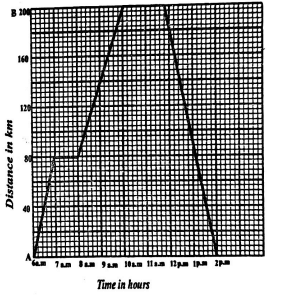
What was the average speed for the whole journey?- 25 km/hr
- 50 km/hr
- 30 km/hr
- 80 km/hr
- There is a 20% loss when an article is sold at sh. 720.00. At what price should it be sold to make a profit of 5%?
- Sh. 956
- Sh. 1 015.00
- Sh. 900
- Sh. 945.00
MARKING SCHEME
- D
- B
- C
- A
- D
- B
- C
- A
- D
- B
- C
- A
- D
- B
- C
- A
- D
- B
- C
- A
- D
- A
- B
- D
- C
- C
- B
- A
- C
- B
- D
- A
- C
- B
- D
- A
- C
- B
- D
- A
- C
- A
- B
- D
- A
- C
- D
- A
- B
- D


